A State-of-the-Art Review of Wind Turbine Blades: Principles, Flow-Induced Vibrations, Failure, Maintenance, and Vibration Suppression Techniques
Abstract
1. Introduction
2. Types of Wind Turbines
3. Principle of Wind Turbine Blade
3.1. Aerodynamics
3.2. Structural Consideration
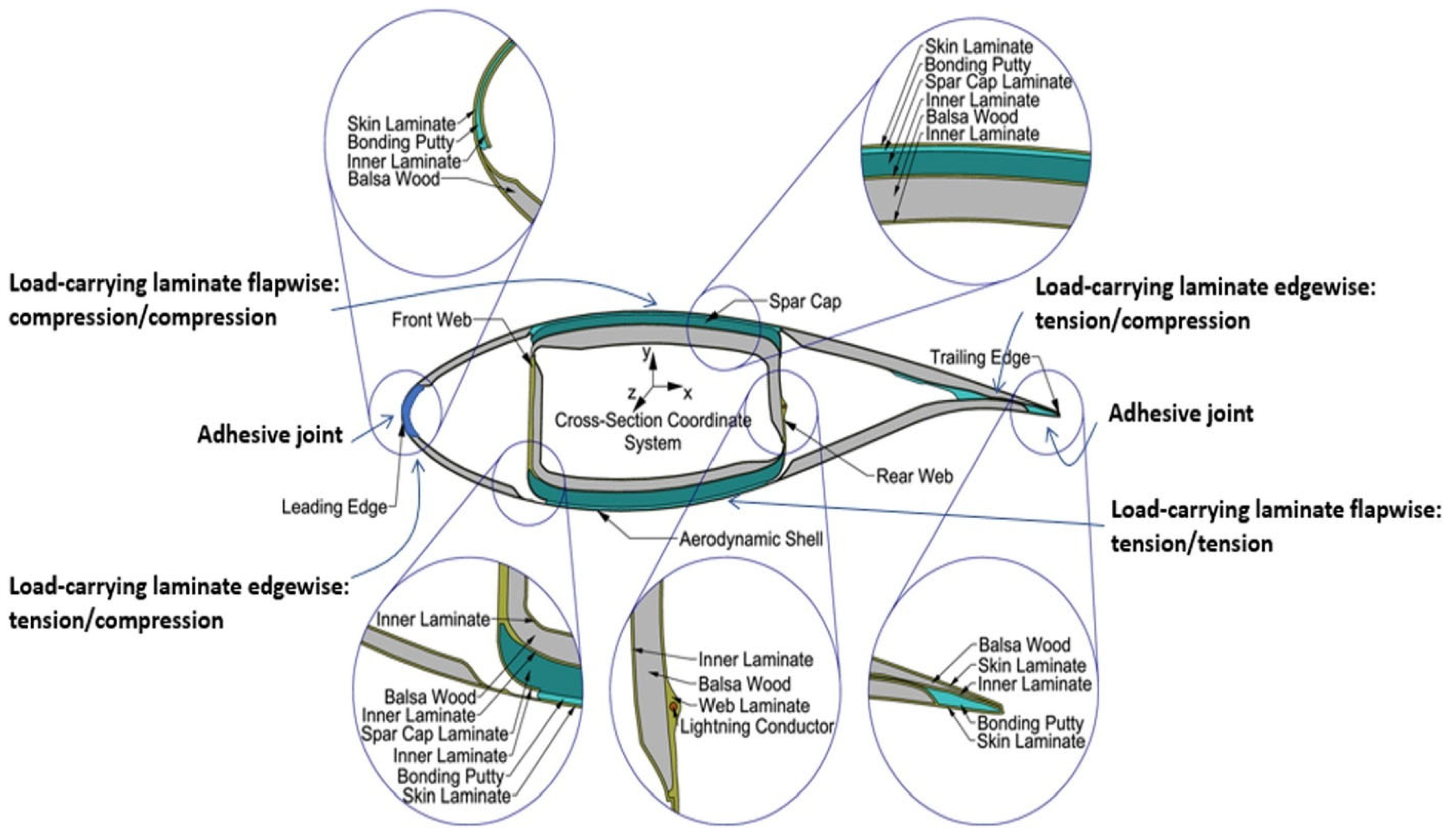
3.3. Material
| Period | Types | Description | Advantages |
|---|---|---|---|
| Early years: 1970–1980 | Wood | Laminated wood was used in early wind turbine blades, often in small-scale turbines. | Readily available and easy to shape. |
| 1981–1990 | Fiberglass | Fiberglass became the most commonly used material due to its lightweight and high strength. Composites are often made with epoxy or polyester resins. | High strength-to-weight ratio, corrosion, and resistance. |
| 1991–2000 | Wood—epoxy composites | The integration of wood fibers with epoxy represented a major improvement over traditional wood construction, enhancing both strength and durability. | Cost-effective with better mechanical properties. |
| 2001–present | Carbon-fiber-reinforced plastics and glass-fiber-reinforced plastics | Carbon fiber composites, combined with resins, offer high performance and low weight. Glass fibers are also used in blade manufacturing due to their low cost and ease of production. | Good mechanical properties and low cost. Environmentally friendly and sustainable. |
| Recent Developments: 2010–present | Natural fiber composites | Natural fiber composites, such as those made from hemp, flax, and jute, are receiving increasing attention due to their moderate mechanical properties and sustainability benefits. | Environmentally friendly and sustainable. |
| Present and Emerging: 2020–present | Biocomposites (natural fibers + bio-based resins); thermoplastic composites; and bamboo composites | Biocomposites—made from natural fibers such as flax or bamboo combined with bio-based resins like PLA or plant oil epoxy—offer advantages in sustainability, recyclability, and weight reduction. While thermoplastics like polypropylene (PP) and polyamide (PA) are being explored for recyclable wind turbine blades, bamboo fibers are particularly valued for their resilience. | High recyclability and faster manufacturing times. Sustainable and low-cost with good mechanical performance. |
| Area | Methodology | Pros | Restrictions |
|---|---|---|---|
| Aerodynamics | Blade element momentum (BEM) rheory | Simple and effective for design improvement | Not very accurate in unstable or complicated flow conditions |
| CFD simulations | Better reliability in aerodynamic estimations | High computational cost AND needs expertise | |
| Active flow control (AFC) | Expand proficiency by flow control | Difficult integration and energy requirements | |
| Multi-objective optimization | Optimizes multiple aerodynamics parameters | High dependence on modal precision | |
| Structure | Tapered and swept blades | Decreases unstable loads and enhances fatigue life | Manufacturing complications |
| Aeroelastic tailoring | Increases the load regulator via material alignment | Needs high accuracy in the design and material positioning | |
| Topology optimization | Effective material utilization and novel structural arrangements | Frequently produces unproducible shapes | |
| Smart structural integration | Active load adjustments by embedded sensors/actuators | Costly and dependability in fatigue is still under research | |
| Materials | Hybrid composites | Moderate strength, resistance to fatigue, and low cost | Interfacial bonding and compatibility issues |
| Nano-enhanced materials | Enhanced durability with sensing capability | Costly and expandability issues | |
| Glass-fiber-reinforced plastics | Economical, decent tensile strength, erosion resistance, and largely utilized in current wind turbine blades | Lesser stiffness and fatigue resistance compared to carbon fiber composites and susceptible to deprivation under long-term UV exposure | |
| Manufacturing | Vacuum-assisted resin infusion (VARI) | Economical, good for big blades, and scalable | Takes a longer time to cure with risks of dry spots |
| Resin transfer molding (RTM) | High-quality finishing and improved fiber volume regulation | Higher molding cost and prone to leakages | |
| Additive manufacturing | Quick prototyping and customizable geometry | Restricted to molds and non-structural parts currently |
3.4. Manufacturing Processes
4. Flow-Induced Vibrations
4.1. Basic Principles and Types of Flow-Induced Vibrations
4.2. Impact of Vibrations on Turbine Performance and Longevity
5. Vibration Suppression Techniques
5.1. Active and Passive Vibration Control Methods
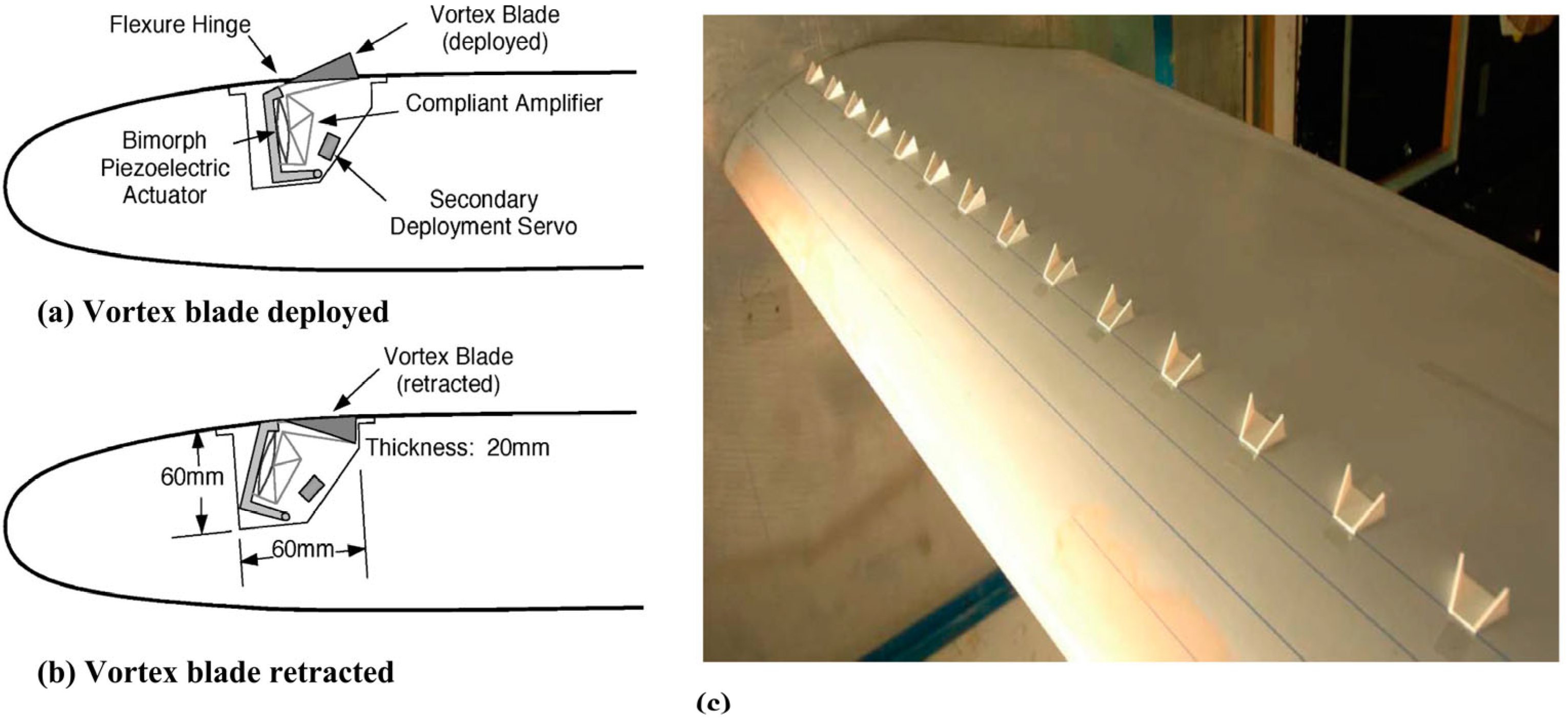
5.2. Design Modifications and Innovative Materials for Vibration Reduction
5.3. Recent Innovations and Research in Vibration Suppression
6. Failure Mechanisms in Wind Turbine Blades
6.1. Types of Failures
6.2. Failure Detection Method
7. Preventive Maintenance and Early Damage Techniques
7.1. Regular Monitoring
7.2. Lubrication and Protective Coatings
7.3. Early Damage Detection
8. Inspections, Repair, and Developing Maintenance Technologies
8.1. Inspections and Repair Strategies
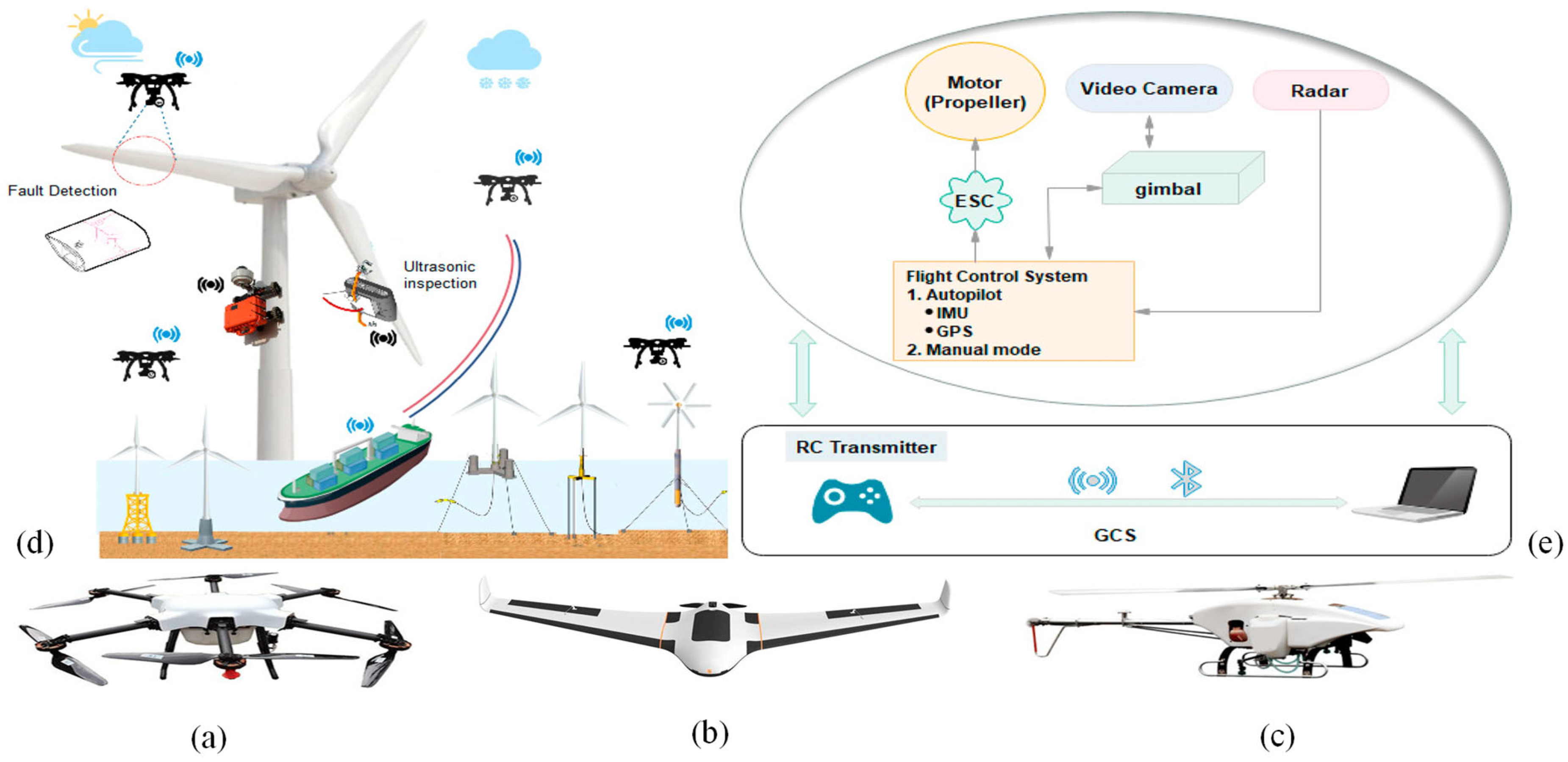
8.2. Challenges and Advancements in Maintenance Solutions
9. Conclusions
Author Contributions
Funding
Data Availability Statement
Conflicts of Interest
References
- Armaroli, N.; Balzani, V. The future of energy supply: Challenges and opportunities. Angew. Chem. Int. Ed. 2007, 46, 52–66. [Google Scholar] [CrossRef] [PubMed]
- Dincer, F. The analysis on wind energy electricity generation status, potential and policies in the world. Renew. Sustain. Energy Rev. 2011, 15, 5135–5142. [Google Scholar] [CrossRef]
- Rehman, S.; Al-Hadhrami, L.M.; Alam, M.M. Pumped hydro energy storage system: A technological review. Renew. Sustain. Energy Rev. 2015, 44, 586–598. [Google Scholar] [CrossRef]
- Herzog, A.V.; Lipman, T.E.; Kammen, D.M. Renewable energy sources. In Encyclopedia of Life Support Systems (EOLSS). Forerunner Volume-‘Perspectives and Overview of Life Support Systems and Sustainable Development; Eolss Publisher: Oxford, UK, 2001; p. 76. [Google Scholar]
- Ritchie, H. What Are the Safest and Cleanest Sources of Energy? Our World in Data: Oxford, UK, 2020. [Google Scholar]
- Tummala, A.; Velamati, R.K.; Sinha, D.K.; Indraja, V.; Krishna, V.H. A review on small scale wind turbines. Renew. Sustain. Energy Rev. 2016, 56, 1351–1371. [Google Scholar] [CrossRef]
- Rehman, S.; Aliyu, K.N.; Alhems, L.M.; Mohandes, M.A.; Himri, Y.; Allouhi, A.; Alam, M.M. A comprehensive global review of building integrated photovoltaic power systems. FME Trans. 2021, 49, 253–268. [Google Scholar] [CrossRef]
- Vasudevan, M.; Natarajan, N.; Kumar, E.S.; Tamizharasu, S.; Rehman, S.; Alhems, L.M.; Alam, M.M. Environmental and Socio-Economic Aspects of Public Acceptance of Wind Farms in Tamil Nadu, India–Key Observations and a Conceptual Framework for Social Inclusion. Pol. J. Environ. Stud. 2023, 32, 3339–3353. [Google Scholar] [CrossRef]
- Allamehzadeh, H. Wind energy history, technology and control. In Proceedings of the2016 IEEE Conference on Technologies for Sustainability (SusTech), Phoenix, AZ, USA, 9–11 October 2016; pp. 119–126. [Google Scholar]
- Gipe, P.; Möllerström, E. An overview of the history of wind turbine development: Part I—The early wind turbines until the 1960s. Wind. Eng. 2022, 46, 1973–2004. [Google Scholar] [CrossRef]
- Ragheb, M. History of harnessing wind power. In Wind Energy Engineering; Academic Press: New York, NY, USA, 2017; pp. 127–143. [Google Scholar]
- Baker, C. Wind engineering—Past, present and future. J. Wind. Eng. Ind. Aerodyn. 2007, 95, 843–870. [Google Scholar] [CrossRef]
- Dodge, D.M. Illustrated History of Wind Power Development; Astra Publishing House: New York, NY, USA, 2001. [Google Scholar]
- Alam, M.M.; Rehman, S.; Meyer, J.P.; Al-Hadhrami, L.M. Review of 600–2500 kW sized wind turbines and optimization of hub height for maximum wind energy yield realization. Renew. Sustain. Energy Rev. 2011, 15, 3839–3849. [Google Scholar] [CrossRef]
- Ragheb, M. Historical Wind Generators Machines. 2009. Available online: https://www.mragheb.com/NPRE%20475%20Wind%20Power%20Systems/Historical%20Wind%20Generators%20Machines.pdf (accessed on 16 February 2025).
- Soter, S.; Wegener, R. Development of induction machines in wind power technology. In Proceedings of the 2007 IEEE International Electric Machines & Drives Conference, Antalya, Turkey, 3–5 May 2007. [Google Scholar] [CrossRef]
- Global Wind Energy Council (GWEC). Global Wind Report 2024; GWEC: Brussels, Belgium, 2024. [Google Scholar]
- Márquez, F.P.G.; Pérez, J.M.P.; Marugán, A.P.; Papaelias, M. Identification of critical components of wind turbines using FTA over the time. Renew. Energy 2016, 87, 869–883. [Google Scholar] [CrossRef]
- Rezamand, M.; Kordestani, M.; Carriveau, R.; Ting, D.S.; Orchard, M.E.; Saif, M. Critical wind turbine components prognostics: A comprehensive review. IEEE Trans. Instrum. Meas. 2020, 69, 9306–9328. [Google Scholar] [CrossRef]
- Su, B.; Guo, T.; Alam, M.M. A review of wind energy harvesting technology: Civil engineering resource, theory, optimization, and application. Appl. Energy 2025, 389, 125771. [Google Scholar] [CrossRef]
- Söker, H. Loads on wind turbine blades. In Advances in Wind Turbine Blade Design and Materials; Woodhead Publishing: Cambridge, UK, 2013; pp. 55–78. [Google Scholar]
- Yang, B.; Sun, D. Testing, inspecting and monitoring technologies for wind turbine blades: A survey. Renew. Sustain. Energy Rev. 2013, 22, 515–526. [Google Scholar] [CrossRef]
- Alam, M.M. A review of wind turbine blade morphing: Power, vibration, and noise. Fluid Dyn. Mater. Process. 2025, 21, 657–695. [Google Scholar] [CrossRef]
- Carroll, J.; McDonald, A.; McMillan, D. Failure rate, repair time and unscheduled O&M cost analysis of offshore wind turbines. Wind Energy 2016, 19, 1107–1119. [Google Scholar]
- Chen, X. Fracture of wind turbine blades in operation—Part I: A comprehensive forensic investigation. Wind Energy 2018, 21, 1046–1063. [Google Scholar] [CrossRef]
- Mishnaevsky, J.L. Repair of wind turbine blades: Review of methods and related computational mechanics problems. Renew. Energy 2019, 140, 828–839. [Google Scholar] [CrossRef]
- Mishnaevsky, L. Root causes and mechanisms of failure of wind turbine blades: Overview. Materials 2022, 15, 2959. [Google Scholar] [CrossRef]
- Katsaprakakis, D.A.; Papadakis, N.; Ntintakis, I. A comprehensive analysis of wind turbine blade damage. Energies 2021, 14, 5974. [Google Scholar] [CrossRef]
- Muheisen, A.H.; Yass, M.A.; Irthiea, I.K. Enhancement of horizontal wind turbine blade performance using multiple airfoils sections and fences. J. King Saud Univ.-Eng. Sci. 2023, 35, 69–81. [Google Scholar] [CrossRef]
- Nabhani, A.; Tousi, N.M.; Coma, M.; Bugeda, G.; Bergadà, J.M. Large-scale horizontal axis wind turbine aerodynamic efficiency optimization using active flow control and synthetic jets. Energy 2025, 319, 134940. [Google Scholar] [CrossRef]
- Adeyeye, K.A.; Ijumba, N.; Colton, J. The effect of the number of blades on the efficiency of a wind turbine. In Proceedings of the IOP Conference Series: Earth and Environmental Science; IOP Publishing: Bristol, UK, 2021; Volume 801, p. 012020. [Google Scholar]
- Zhang, L.A.; Guo, Y.; Wang, J.; Huang, X.; Wei, X.; Liu, W. Structural failure test of a 52.5 m wind turbine blade under combined loading. Eng. Fail. Anal. 2019, 103, 286–293. [Google Scholar] [CrossRef]
- Roberts, D. These Huge New Wind Turbines Are a Marvel. They’re Also the Future. Available online: https://www.vox.com (accessed on 20 May 2019).
- Hernandez Crespo, B. Damage Sensing in Blades. In MARE-WINT: New Materials and Reliability in Offshore Wind Turbine Technology; Ostachowicz, W., McGugan, M., Schröder-Hinrichs, J.-U., Luczak, M., Eds.; Springer: Cham, Switzerland, 2016; pp. 25–52. [Google Scholar]
- O’Neill, S. Giant Turbines Poised to Claim Offshore Wind. Engineering 2021, 7, 894–896. [Google Scholar] [CrossRef]
- Rehman, S.; Alhems, L.M.; Alam, M.M.; Wang, L.; Toor, J. A review of energy extraction from wind and ocean: Technologies, merits, efficiencies, and cost. Ocean Eng. 2023, 267, 113192. [Google Scholar] [CrossRef]
- Holierhoek, J. An overview of possible aeroelastic instabilities for wind turbine blades. Wind Eng. 2013, 37, 421–440. [Google Scholar] [CrossRef]
- Jiang, Z.; Karimirad, M.; Moan, T. Dynamic response analysis of wind turbines under blade pitch system fault, grid loss, and shutdown events. Wind Energy 2014, 17, 1385–1409. [Google Scholar] [CrossRef]
- Gharbia, Y.; Derakhshandeh, J.F.; Alam, M.M.; Amer, A.M.F. Developments in wingtip vorticity mitigation techniques: A comprehensive review. Aerospace 2024, 11, 36. [Google Scholar] [CrossRef]
- Thapa, M.; Missoum, S. Surrogate-Based Stochastic Optimization of Horizontal-Axis Wind Turbine Composite Blades. Struct. Multidiscip. Optim. 2022, 65, 41. [Google Scholar] [CrossRef]
- McKenna, R.; vd Leye, P.O.; Fichtner, W. Key challenges and prospects for large wind turbines. Renew. Sustain. Energy Rev. 2016, 53, 1212–1221. [Google Scholar] [CrossRef]
- Sayed, E.T.; Olabi, A.G.; Alami, A.H.; Radwan, A.; Mdallal, A.; Rezk, A.; Abdelkareem, M.A. Renewable energy and energy storage systems. Energies 2023, 16, 1415. [Google Scholar] [CrossRef]
- Boztaş, A.; Demirbaş, O.; Şahin, M.E. Investigation of vertical axis wind turbines and the design of their components. Turk. J. Electromech. Energy 2021, 6, 64–72. [Google Scholar]
- Gohar, G.A.; Manzoor, T.; Ahmad, A.; Hameed, Z.; Saleem, F.; Ahmad, I.; Sattar, A.; Arshad, A. Design and comparative analysis of an INVELOX wind power generation system for multiple wind turbines through computational fluid dynamics. Adv. Mech. Eng. 2019, 11, 1687814019831475. [Google Scholar] [CrossRef]
- Kennedy, I.R.; Hodzic, M.; Crossan, A.N.; Crossan, N.; Acharige, N.; Runcie, J.W. Estimating Maximum Power from Wind Turbines with a Simple Newtonian Approach. Arch. Adv. Eng. Sci. 2023, 1, 38–54. [Google Scholar] [CrossRef]
- Arini, N.R.; Muhammad, G.; Pratilastiarso, J.; Tridianto, E.; Sumantri, B.; Nugroho, S. Prediction on the Maximum Lift Force of Twisted Clark Y Wind Turbine Blade with 30° Winglet Tip in Various Pitch Angles Using CFD Method. In Proceedings of the IOP Conference Series: Earth and Environmental Science; IOP Publishing: Bristol, UK, 2022; Volume 1121, p. 012010. [Google Scholar]
- Masud, M.H.; Hemal, M.F.; Ahmed, M.M.; Taki, M.F.; Himel, M.H.; Ananno, A.A.; Dabnichki, P. Effect of Aerodynamics on Wind Turbine Design. In Wind Energy Storage and Conversion: From Basics to Utilities; Inamuddin, A.T., Luqman, M., Eds.; Wiley-Scrivener: Beverly, MA, USA, 2024; pp. 207–245. [Google Scholar]
- Belfkira, Z.; Mounir, H.; El Marjani, A. New Investigation of Mechanical Properties of a Horizontal Axis Wind Turbine Blade Based on a Hybrid Composites with Kenaf Fibers. SN Appl. Sci. 2020, 2, 233. [Google Scholar] [CrossRef]
- Genov, J. Some Aspects of the Influence of the Vertical Wind Speed Gradient on the Blade Aerodynamics Loads in High Class Wind Generators. In Proceedings of the MATEC Web of Conferences; EDP Sciences: Les Ulis, France, 2018; Volume 234, p. 04006. [Google Scholar]
- Almukhtar, A.H. Effect of Drag on the Performance for an Efficient Wind Turbine Blade Design. Energy Procedia 2012, 18, 404–415. [Google Scholar] [CrossRef]
- Eastlake, C.N. An Aerodynamicist’s View of Lift, Bernoulli, and Newton. Phys. Teach. 2002, 40, 166–173. [Google Scholar] [CrossRef]
- Karthikeyan, U.; Hussain, J. Enhancing the Efficiency of Wind Energy Conversion Systems Using Novel Airfoil-Based Small Scale Wind Turbine. Matéria 2025, 30, e20240827. [Google Scholar] [CrossRef]
- Liu, T. Evolutionary Understanding of Airfoil Lift. Adv. Aerodyn. 2021, 3, 37. [Google Scholar] [CrossRef]
- Debbache, M.; Hazmoune, M.; Derfouf, S.; Ciupageanu, D.A.; Lazaroiu, G. Wind Blade Twist Correction for Enhanced Annual Energy Production of Wind Turbines. Sustainability 2021, 13, 6931. [Google Scholar] [CrossRef]
- Zhou, Y.; Alam, M.M.; Yang, H.X.; Guo, H.; Wood, D.H. Fluid Forces on a Very Low Reynolds Number Airfoil and Their Prediction. Int. J. Heat Fluid Flow 2011, 32, 329–339. [Google Scholar] [CrossRef]
- Wang, S.; Zhou, Y.; Alam, M.M.; Yang, H. Turbulent Intensity and Reynolds Number Effects on an Airfoil at Low Reynolds Numbers. Phys. Fluids 2014, 26, 111702. [Google Scholar] [CrossRef]
- Alam, M.M.; Zhou, Y.; Yang, H.X.; Guo, H.; Mi, J. The Ultra-Low Reynolds Number Airfoil Wake. Exp. Fluids 2010, 48, 81–103. [Google Scholar] [CrossRef]
- Wang, L.; Alam, M.M.; Zhou, Y. Experimental Study of a Passive Control of Airfoil Lift Using Bioinspired Feather Flap. Bioinspiration Biomim. 2019, 14, 066005. [Google Scholar] [CrossRef] [PubMed]
- Wang, L.; Alam, M.M.; Rehman, S.; Zhou, Y. Effects of Blowing and Suction Jets on the Aerodynamic Performance of Wind Turbine Airfoil. Renew. Energy 2022, 196, 52–64. [Google Scholar] [CrossRef]
- Zhong, W.; Shen, W.Z.; Wang, T.G.; Zhu, W.J. A New Method of Determination of the Angle of Attack on Rotating Wind Turbine Blades. Energies 2019, 12, 4012. [Google Scholar] [CrossRef]
- Rezaeiha, A.; Pereira, R.; Kotsonis, M. Fluctuations of Angle of Attack and Lift Coefficient and the Resultant Fatigue Loads for a Large Horizontal Axis Wind Turbine. Renew. Energy 2017, 114, 904–916. [Google Scholar] [CrossRef]
- Thumthae, C.; Chitsomboon, T. Optimal angle of attack for untwisted blade wind turbine. Renew. Energy 2009, 34, 1279–1284. [Google Scholar] [CrossRef]
- Bakırcı, M.; Yılmaz, S. Theoretical and computational investigations of the optimal tip-speed ratio of horizontal-axis wind turbines. Eng. Sci. Technol. Int. J. 2018, 21, 1128–1142. [Google Scholar] [CrossRef]
- Yurdusev, M.; Ata, R.; Çetin, N. Assessment of optimum tip speed ratio in wind turbines using artificial neural networks. Energy 2006, 31, 2153–2161. [Google Scholar] [CrossRef]
- Sriti, M. Improved blade element momentum theory (BEM) for predicting the aerodynamic performances of horizontal Axis wind turbine blade (HAWT). Tech. Mech.-Eur. J. Eng. Mech. 2018, 38, 191–202. [Google Scholar]
- Ledoux, J.; Riffo, S.; Salomon, J. Analysis of the blade element momentum theory. SIAM J. Appl. Math. 2021, 81, 2596–2621. [Google Scholar] [CrossRef]
- Firoozi, A.A.; Hejazi, F.; Firoozi, A.A. Advancing Wind Energy Efficiency: A Systematic Review of Aerodynamic Optimization in Wind Turbine Blade Design. Energies 2024, 17, 2919. [Google Scholar] [CrossRef]
- Lahoz, M.; Nabhani, A.; Saemian, M.; Bergada, J.M. Wind turbine enhancement via active flow control implementation. Appl. Sci. 2024, 14, 11404. [Google Scholar] [CrossRef]
- Nair, R.R.; Babu, T.; Kumar, K.N.; Vardhan, R.G. Evolutionary Algorithms for Optimizing Wind Turbine Blade Design. In Proceedings of the 2024 International Conference on IT Innovation and Knowledge Discovery (ITIKD), Manama, Bahrain, 13–15 April 2025; pp. 1–6. [Google Scholar]
- Jasa, J.; Glaws, A.; Bortolotti, P.; Vijayakumar, G.; Barter, G. Wind Turbine Blade Design with Airfoil Shape Control Using Invertible Neural Networks. In IOP Conference Series: Physics and Engineering; IOP Publishing: Bristol, UK, 2022; Volume 2265, p. 042052. [Google Scholar]
- Zhu, W.J.; Shen, W.Z.; Sørensen, J.N. Integrated airfoil and blade design method for large wind turbines. Renew. Energy 2014, 70, 172–183. [Google Scholar] [CrossRef]
- Lucena, J.d.A.Y. Recent advances and technology trends of wind turbines. Recent Adv. Renew. Energy Technol. 2021, 1, 177–210. [Google Scholar]
- Karthikeyan, N.; Anand, R.; Suthakar, T.; Barhate, S. Materials, Innovations and Future Research Opportunities on Wind Turbine Blades—Insight Review. Environ. Prog. Sustain. Energy 2019, 38, e13046. [Google Scholar] [CrossRef]
- Gambier, A. Pitch Control of Three Bladed Large Wind Energy Converters—A Review. Energies 2021, 14, 8083. [Google Scholar] [CrossRef]
- Namik, H.; Stol, K. Individual blade pitch control of floating offshore wind turbines. Wind Energy Int. J. Prog. Appl. Wind. Power Convers. Technol. 2010, 13, 74–85. [Google Scholar] [CrossRef]
- Kong, K.; Dyer, K.; Payne, C.; Hamerton, I.; Weaver, P.M. Progress and trends in damage detection methods, maintenance, and data-driven monitoring of wind turbine blades—A review. Renew. Energy Focus 2023, 44, 390–412. [Google Scholar] [CrossRef]
- Huang, X.; Yang, J.; Gao, Z.; Sha, C.; Yang, H. Output power and wake flow characteristics of a wind turbine with swept blades. Machines 2022, 10, 876. [Google Scholar] [CrossRef]
- Song, J.; Chen, J.; Wu, Y.; Li, L. Topology optimization-driven design for offshore composite wind turbine blades. J. Mar. Sci. Eng. 2022, 10, 1487. [Google Scholar] [CrossRef]
- Schubel, P.J.; Crossley, R.J. Wind Turbine Blade Design. Energies 2012, 5, 3425–3449. [Google Scholar] [CrossRef]
- Thomas, L.; Ramachandra, M. Advanced Materials for Wind Turbine Blade—A Review. Mater. Today Proc. 2018, 5, 2635–2640. [Google Scholar] [CrossRef]
- Singh, V.K.; Thomas, T.T.; Warudkar, V. Structural Design of a Wind Turbine Blade: A Review. Int. J. ChemTech Res. 2013, 5, 2443–2448. [Google Scholar]
- Brøndsted, P.; Holmes, J.W.; Sørensen, B.F.; Sun, Z. Bamboo Based Composites for Wind Turbine Blades; Materials Research Division, Risø; DTU, The Technical University of Denmark: Kongens Lyngby, Denmark, 2009. [Google Scholar]
- Wibawa, Y.M.; Irawan, A.P.; Djamil, S.; Abdullah, M.Z. Development of Wind Turbine Blade Using Bamboo Fiber Composite Material. In AIP Conference Proceedings; AIP Publishing: New York, NY, USA, 2023; Volume 2680. [Google Scholar]
- Mengesha, G. Advances in Composite Structures: A Systematic Review of Design, Performance, and Sustainability Trends. Perform. Sustain. Trends 2025, 9, 1–17. [Google Scholar] [CrossRef]
- Qin, Y.; Xu, J.; Zhang, Y. Bamboo as a potential material used for wind turbine blades. In Technological and Socio-Economic Planning-Technical Report; Roskilde University: Roskilde, Denmark, 2009; pp. 1–55. [Google Scholar]
- Rashedi, A.; Sridhar, I.; Tseng, K.J. Multi-Objective Material Selection for Wind Turbine Blade and Tower: Ashby’s Approach. Mater. Des. 2012, 37, 521–532. [Google Scholar] [CrossRef]
- Dathu, K.P.; Hariharan, R. Design of Wind Turbine Blade Material for Higher Efficiency. Mater. Today Proc. 2020, 33, 565–569. [Google Scholar] [CrossRef]
- Firoozi, A.A.; Firoozi, A.A.; Hejazi, F. Innovations in Wind Turbine Blade Engineering: Exploring Materials, Sustainability, and Market Dynamics. Sustainability 2024, 16, 8564. [Google Scholar] [CrossRef]
- Alwekar, S.; Yeole, P.; Herring, C.; Richardson, B.; Hassen, A.A.; Morris, E.; Vaidya, U. Large-Scale Additive Manufacturing Resin Transfer Molding (RTM) for Hydroelectric Turbine Blades. In Proceedings of the 8th Annual Composites and Advanced Materials Expo, CAMX; The Composites and Advanced Materials Expo (CAMX): Orlando, FL, USA, 2021; pp. 1102–1112. [Google Scholar]
- Pedneau, E. Processing of MW-Scale Wind Turbine Rotor Blades by Vacuum-Assisted Resin Infusion Molding; HM Government: London, UK,, 2023; 144, p. 071013.
- Olivera, A.F.; Chica, E.; Colorado, H.A. Design and manufacturing with 3D printing and life cycle analysis of a recyclable polymer-based H-Darrieus wind turbine. Eng. Sci. 2024, 31, 1156. [Google Scholar] [CrossRef]
- Veers, P.S.; Ashwill, T.D.; Sutherland, H.J.; Laird, D.L.; Lobitz, D.W.; Griffin, D.A.; Mandell, J.F.; Musial, W.D.; Jackson, K.; Zuteck, M.; et al. Trends in the Design, Manufacture and Evaluation of Wind Turbine Blades. Wind Energy Int. J. Prog. Appl. Wind. Power Convers. Technol. 2003, 6, 245–259. [Google Scholar] [CrossRef]
- Bhatt, R.; Alam, M.M. Vibration of a Square Cylinder Submerged in a Wake. J. Fluid Mech. 2018, 853, 301–332. [Google Scholar] [CrossRef]
- Alam, M.M. A Note on Flow-Induced Force Measurement of Oscillating Cylinder by Loadcell. Ocean Eng. 2022, 245, 110538. [Google Scholar] [CrossRef]
- Alam, M.M. New Scaling of Critical Damping and Reduced Frequency for Mechanically Excited Systems. Sound Vib. 2025, 59, 2600. [Google Scholar] [CrossRef]
- Alam, M.M. Flow-Induced Vibrations of Various Bluff Bodies: A Review of Blockage and Wall Effects. J. Fluids Struct. 2025, 136, 104328. [Google Scholar] [CrossRef]
- Nakamura, T.; Kaneko, S.; Inada, F.; Kato, M.; Ishihara, K.; Nishihara, T.; Mureithi, N.W.; Langthjem, M.A. (Eds.) Flow-Induced Vibrations: Classifications and Lessons from Practical Experiences; Butterworth-Heinemann: Oxford, UK, 2013. [Google Scholar]
- Alam, M.M.; Meyer, J.P. Global Aerodynamic Instability of Twin Cylinders in Cross Flow. J. Fluids Struct. 2013, 41, 135–145. [Google Scholar] [CrossRef]
- Guma, G.; Bangga, G.; Lutz, T.; Krämer, E. Aero-elastic analysis of wind turbines under turbulent inflow conditions. Wind Energy Sci. Discuss. 2020, 2020, 93–110. [Google Scholar]
- Zhu, C.; Chen, J.; Wu, J.; Wang, T. Dynamic stall control of the wind turbine airfoil via single-row and double-row passive vortex generators. Energy 2019, 189, 116272. [Google Scholar] [CrossRef]
- Bashir, M.; Rajendran, P.; Khan, S.A. Energy Harvesting from Aerodynamic Instabilities: Current Prospect and Future Trends. In IOP Conference Series: Materials Science and Engineering; IOP Publishing: Bristol, UK, 2018; Volume 290, p. 012054. [Google Scholar]
- Lo, J.C.; Hourigan, K.; Thompson, M.C.; Zhao, J. The Effect of Structural Damping on Flow-Induced Vibration of a Thin Elliptical Cylinder. J. Fluid Mech. 2023, 974, A5. [Google Scholar] [CrossRef]
- Rostami, A.B.; Armandei, M. Renewable Energy Harvesting by Vortex-Induced Motions: Review and Benchmarking of Technologies. Renew. Sustain. Energy Rev. 2017, 70, 193–214. [Google Scholar] [CrossRef]
- Sun, W.; Jo, S.; Seok, J. Development of the Optimal Bluff Body for Wind Energy Harvesting Using the Synergetic Effect of Coupled Vortex Induced Vibration and Galloping Phenomena. Int. J. Mech. Sci. 2019, 156, 435–445. [Google Scholar] [CrossRef]
- Wu, Y.; Cheng, Z.; McConkey, R.; Lien, F.S.; Yee, E. Modelling of Flow-Induced Vibration of Bluff Bodies: A Comprehensive Survey and Future Prospects. Energies 2022, 15, 8719. [Google Scholar] [CrossRef]
- Alam, M.M. Effects of Mass and Damping on Flow-Induced Vibration of a Cylinder Interacting with the Wake of Another Cylinder at High Reduced Velocities. Energies 2021, 14, 5148. [Google Scholar] [CrossRef]
- Qin, B.; Alam, M.M.; Zhou, Y. Two Tandem Cylinders of Different Diameters in Crossflow: Flow-Induced Vibration. J. Fluid Mech. 2017, 829, 621–658. [Google Scholar] [CrossRef]
- Qin, B.; Alam, M.M.; Ji, C.; Liu, Y.; Xu, S. Flow-Induced Vibration of Two Cylinders of Different Natural Frequencies. Ocean Eng. 2018, 155, 189–200. [Google Scholar] [CrossRef]
- Qin, B.; Alam, M.M.; Zhou, Y. Free Vibrations of Two Tandem Elastically Mounted Cylinders in Cross-Flow. J. Fluid Mech. 2019, 861, 349–381. [Google Scholar] [CrossRef]
- Kim, S.; Alam, M.M.; Sakamoto, H.; Zhou, Y. Flow-Induced Vibration of Two Circular Cylinders in Tandem Arrangement. Part 2: Suppression of Vibrations. J. Wind Eng. Ind. Aerodyn. 2009, 97, 312–319. [Google Scholar] [CrossRef]
- Chen, W.; Ji, C.; Alam, M.M.; Xu, D.; An, H.; Tong, F.; Zhao, Y. Flow-Induced Vibrations of a D-Section Prism at a Low Reynolds Number. J. Fluid Mech. 2022, 941, A52. [Google Scholar] [CrossRef]
- Chen, W.; Alam, M.M.; Li, Y.; Ji, C. Two-Degree-of-Freedom Flow-Induced Vibrations of a D-Section Prism. J. Fluid Mech. 2023, 971, A5. [Google Scholar] [CrossRef]
- Liu, J.; Alam, M.M.; Zhu, H.; Islam, M.; Zhou, Y.; Zeinoddini, M. Flow-Induced Vibrations of a Wake Cylinder at a Low Mass-Damping Ratio. Ocean Eng. 2025, 322, 120530. [Google Scholar] [CrossRef]
- Zhu, H.; Zhong, J.; Shao, Z.; Zhou, T.; Alam, M.M. Fluid-structure interaction among three tandem circular cylinders oscillating transversely at a low Reynolds number of 150. J. Fluids Struct. 2024, 130, 104204. [Google Scholar] [CrossRef]
- Zhou, Q.; Cao, S.; Alam, M.M.; Han, B. Aerodynamics of a 5: 1 rectangular cylinder under transient accelerated and decelerated winds. J. Wind. Eng. Ind. Aerodyn. 2025, 258, 106023. [Google Scholar] [CrossRef]
- Nejadali, J. Design Improvement of the Small-Scale Vortex-Induced Bladeless Wind Turbine Considering the Characteristic Length of the Oscillating Structure. Iran. J. Sci. Technol. Trans. Mech. Eng. 2024, 48, 1839–1850. [Google Scholar] [CrossRef]
- Zdravkovich, M.M. Flow Around Circular Cylinders: Volume 2: Applications; Oxford University Press: Oxford, UK, 1997. [Google Scholar]
- Alam, M.M. Fluid Force, Moment, and Torque Measurements of Oscillating Prism and Cylinder Using Loadcell. Phys. Fluids 2022, 34, 127108. [Google Scholar] [CrossRef]
- Williamson, C.H.; Roshko, A. Vortex formation in the wake of an oscillating cylinder. J. Fluids Struct. 1988, 2, 355–381. [Google Scholar] [CrossRef]
- Wu, Y.; Huang, Y.; Zhao, J. In-line flow-induced vibration of rotating elliptical cylinders. J. Fluids Struct. 2024, 130, 104186. [Google Scholar] [CrossRef]
- Ali, U. Study of Heat Transfer and Flow-Induced Vibrations of Circular Cylinders in Cross Flow. Ph.D. Thesis, Khalifa University of Science, Abu Dhabi, Saudi Arabia, 2024. [Google Scholar]
- Heinz, J.C.; Sørensen, N.N.; Zahle, F.; Skrzypiński, W. Vortex-induced vibrations on a modern wind turbine blade. Wind Energy 2016, 19, 2041–2051. [Google Scholar] [CrossRef]
- Williamson, C.H.; Govardhan, R. Vortex-induced vibrations. Annu. Rev. Fluid Mech. 2004, 36, 413–455. [Google Scholar] [CrossRef]
- Li, X.; Lyu, Z.; Kou, J.; Zhang, W. Mode competition in galloping of a square cylinder at low Reynolds number. J. Fluid Mech. 2019, 867, 516–555. [Google Scholar] [CrossRef]
- Lin, C.; Alam, M.M. Intrinsic features of flow-induced stability of a square cylinder. J. Fluid Mech. 2024, 988, A50. [Google Scholar] [CrossRef]
- Simiu, E.; Scanlan, R.H. Wind Effects on Structures: Fundamentals and Applications to Design; John Wiley: New York, NY, USA, 1996. [Google Scholar]
- Wang, J.; Geng, L.; Ding, L.; Zhu, H.; Yurchenko, D. The state-of-the-art review on energy harvesting from flow-induced vibrations. Appl. Energy 2020, 267, 114902. [Google Scholar] [CrossRef]
- Hansen, M.O.; Sørensen, J.N.; Voutsinas, S.; Sørensen, N.; Madsen, H.A. State of the art in wind turbine aerodynamics and aeroelasticity. Prog. Aerosp. Sci. 2006, 42, 285–330. [Google Scholar] [CrossRef]
- Pourazarm, P.; Caracoglia, L.; Lackner, M.; Modarres-Sadeghi, Y. Stochastic analysis of flow-induced dynamic instabilities of wind turbine blades. J. Wind. Eng. Ind. Aerodyn. 2015, 137, 37–45. [Google Scholar] [CrossRef]
- Zheng, Q.; Gao, Z.; Zhao, B.; Bai, Y.; Su, R.; Han, X.; Zhao, F.; Dong, X.; Wang, J. Experimental study on the influence of centroid position of wind turbine section on flutter. Heliyon 2024, 10, e37039. [Google Scholar] [CrossRef] [PubMed]
- Herath, M.T.; Lee, A.K.; Prusty, B.G. Design of shape-adaptive wind turbine blades using Differential Stiffness Bend–Twist coupling. Ocean Eng. 2015, 95, 157–165. [Google Scholar] [CrossRef]
- Hansen, M.H. Improved modal dynamics of wind turbines to avoid stall-induced vibrations. Wind Energy 2003, 6, 179–195. [Google Scholar] [CrossRef]
- Hansen, M.H. Aeroelastic instability problems for wind turbines. Wind Energy 2007, 10, 551–577. [Google Scholar] [CrossRef]
- Ferrer, E.; Willden, R.H. Blade–wake interactions in cross-flow turbines. Int. J. Mar. Energy 2015, 11, 71–83. [Google Scholar] [CrossRef]
- Reiso, M. The Tower Shadow Effect in Downwind Wind Turbines. Ph.D. Thesis, Norwegian University of Science and Technology (NTNU), Trondheim, Norway, 2013. [Google Scholar]
- Alam, M.M.; Chen, G.; Zhou, Y.; Wang, L.; Wang, J.; Islam, M. Flow-induced vibration of a cantilevered cylinder in the wake of another. J. Fluids Struct. 2023, 120, 103901. [Google Scholar] [CrossRef]
- Win Naung, S.; Rahmati, M.; Shine, H. High-Fidelity Aeroelastic Analysis of a Wind Turbine Using a Nonlinear Frequency-Domain Solution Method. Energies 2025, 18, 1195. [Google Scholar] [CrossRef]
- De Girolamo, F.; Castorrini, A.; Barnabei, V.F.; Morici, V.; Tieghi, L.; Bonfiglioli, A.; Corsini, A. Detached eddy simulation of large-scale wind turbine wake in offshore environment. Int. J. Heat Fluid Flow 2024, 110, 109637. [Google Scholar] [CrossRef]
- Gao, R.; Yang, J.; Yang, H.; Wang, X. Wind-tunnel experimental study on aeroelastic response of flexible wind turbine blades under different wind conditions. Renew. Energy 2023, 219, 119539. [Google Scholar] [CrossRef]
- Asghar, U.; Aziz, I.; Sher, F. Modelling and simulation of flow induced vibrations in vertical axis wind turbine blade. In Proceedings of the 14th International Bhurban Conference on Applied Sciences and Technology (IBCAST), Islamabad, Pakistan, 10 January 2017. [Google Scholar]
- Struggl, S.; Berbyuk, V.; Johansson, H. Review on wind turbines with focus on drive train system dynamics. Wind Energy 2015, 18, 567–590. [Google Scholar] [CrossRef]
- Xu, Z.; Wei, J.; Zhang, S.; Liu, Z.; Chen, X.; Yan, Q.; Guo, J. A state-of-the-art review of the vibration and noise of wind turbine drivetrains. Sustain. Energy Technol. Assess. 2021, 48, 101629. [Google Scholar] [CrossRef]
- Burton, T.; Jenkins, N.; Sharpe, D.; Bossanyi, E. Wind Energy Handbook; John Wiley & Sons: Chichester, UK, 2011. [Google Scholar]
- Sutherland, H.J. On the Fatigue Analysis of Wind Turbines; Report, No. SAND99-0089; Sandia National Laboratories: Albuquerque, NM, USA, 1999.
- Jonkman, J.M. Dynamics Modeling and Loads Analysis of an Offshore Floating Wind Turbine; University of Colorado at Boulder: Boulder, CO, USA, 2007. [Google Scholar]
- Van Kuik, G.A.; Peinke, J.; Nijssen, R.; Lekou, D.; Mann, J.; Sørensen, J.N.; Ferreira, C.; van Wingerden, J.W.; Schlipf, D.; Gebraad, P.; et al. Long-term research challenges in wind energy—A research agenda by the European Academy of Wind Energy. Wind Energy Sci. 2016, 1, 1–39. [Google Scholar] [CrossRef]
- Rahman, M.; Ong, Z.C.; Chong, W.T.; Julai, S.; Khoo, S.Y. Performance enhancement of wind turbine systems with vibration control: A review. Renew. Sustain. Energy Rev. 2015, 51, 43–54. [Google Scholar] [CrossRef]
- Cano Bravo, R.A. Vortex-Induced Motions of a Semi-Submersible Floating Offshore Wind Turbine. Master’s Thesis, Norwegian University of Science and Technology (NTNU), Trondheim, Norway, 2024. [Google Scholar]
- Liu, T.; Cui, Q.; Xu, D. Wind Turbine Composite Blades: A Critical Review of Aeroelastic Modeling and Vibration Control. Fluid Dyn. Mater. Process. 2025, 21, 1–36. [Google Scholar] [CrossRef]
- Xie, F.; Aly, A.M. Structural control and vibration issues in wind turbines: A review. Eng. Struct. 2020, 210, 110087. [Google Scholar] [CrossRef]
- Singh, S.K.; Garg, M.; Narayanan, S.; Ayton, L.; Chaitanya, P. On the reductions of airfoil broadband noise through sinusoidal trailing-edge serrations. J. Aerosp. Eng. 2022, 35, 04022003. [Google Scholar] [CrossRef]
- Yi, Z.; Deyou, L.; Qi, Y.; Biao, Y. Research on the Noise Reduction Mechanisms of Bionic Airfoils with Different Serrated Trailing-Edge Structures. J. Aerosp. Eng. 2025, 38, 04025021. [Google Scholar] [CrossRef]
- Zhang, J.W.; Liang, X.; Wang, L.Z.; Wang, B.X.; Wang, L.L. The influence of tuned mass dampers on vibration control of monopile offshore wind turbines under wind-wave loadings. Ocean Eng. 2023, 278, 114394. [Google Scholar] [CrossRef]
- Hemmati, A.; Oterkus, E.; Khorasanchi, M. Vibration suppression of offshore wind turbine foundations using tuned liquid column dampers and tuned mass dampers. Ocean Eng. 2019, 172, 286–295. [Google Scholar] [CrossRef]
- Colwell, S.; Basu, B. Tuned liquid column dampers in offshore wind turbines for structural control. Eng. Struct. 2009, 31, 358–368. [Google Scholar] [CrossRef]
- Wei, Y.; Cao, Z.; Mal, R.; Liao, M. A Review of Blade Vibration Suppression Methods for Large-Scale Horizontal Axis Wind. In Advances in Applied Nonlinear Dynamics, Vibration, and Control: The Proceedings of 2024 International Conference on Applied Nonlinear Dynamics, Vibration and Control (ICANDVC2024); Springer Nature: Berlin/Heidelberg, Germany, 2024; p. 255. [Google Scholar]
- Fitzgerald, B.; Basu, B. Vibration control of wind turbines: Recent advances and emerging trends. Int. J. Sustain. Mater. Struct. Syst. 2020, 4, 347–372. [Google Scholar] [CrossRef]
- Uygun, M.; Yavuz, A.; Şen, O.T. Design and Evaluation of Piezoelectric-Based Passive Damping for High Frequency Noise Suppression. Sivas Cumhur. Üniv. Bilim Teknol. Derg. 2024, 3, 21–29. [Google Scholar] [CrossRef]
- Awada, A.; Younes, R.; Ilinca, A. Review of vibration control methods for wind turbines. Energies 2021, 14, 3058. [Google Scholar] [CrossRef]
- Staino, A.; Basu, B. Emerging trends in vibration control of wind turbines: A focus on a dual control strategy. Philos. Trans. R. Soc. A Math. Phys. Eng. Sci. 2015, 373, 20140069. [Google Scholar] [CrossRef]
- Zhou, X.Q.; Yu, D.Y.; Shao, X.Y.; Zhang, S.Q.; Wang, S. Research and applications of viscoelastic vibration damping materials: A review. Compos. Struct. 2016, 136, 460–480. [Google Scholar] [CrossRef]
- Wang, J.H.; Shieh, W.L. The influence of a variable friction coefficient on the dynamic behavior of a blade with a friction damper. J. Sound Vib. 1991, 149, 137–145. [Google Scholar] [CrossRef]
- Pathak, S.M.; Kumar, V.P.; Bonu, V.; Mishnaevsky, L., Jr.; Lakshmi, R.V.; Bera, P.; Barshilia, H.C. Development of cellulose-reinforced polyurethane coatings: A novel eco-friendly approach for wind turbine blade protection. Energies 2023, 16, 1730. [Google Scholar] [CrossRef]
- Olajiga, O.K.; Obiuto, N.C.; Adebayo, R.A.; Festus-Ikhuoria, I.C. Advanced Materials for Wind Energy: Reviewing Innovations and Challenges in the USA. Int. J. Adv. Eng. Manag. 2024, 6, 454–465. [Google Scholar]
- Liu, C.; Chen, L.; Lee, H.P.; Yang, Y.; Zhang, X. A review of the inerter and inerter-based vibration isolation: Theory, devices, and applications. J. Frankl. Inst. 2022, 359, 7677–7707. [Google Scholar] [CrossRef]
- Yang, J.J.; Erming, H.E.; Chen, P.X.; Shu, J.C. Application of Hybrid Mass Damper in Vibration Suppression of Floating Offshore Wind Turbine. J. Mech. Eng. 2022, 58, 250–257. [Google Scholar]
- Jahangiri, V.; Sun, C.; Babaei, H. Application of a new two dimensional nonlinear tuned mass damper in bi-directional vibration mitigation of wind turbine blades. Eng. Struct. 2024, 302, 117371. [Google Scholar] [CrossRef]
- Zhang, Z.; Høeg, C. Inerter-enhanced tuned mass damper for vibration damping of floating offshore wind turbines. Ocean Eng. 2021, 223, 108663. [Google Scholar] [CrossRef]
- Jahangiri, V.; Sun, C. A novel two-dimensional nonlinear tuned mass damper inerter and its application in vibration mitigation of wind turbine blade. arXiv 2022, arXiv:2206.14328. [Google Scholar]
- Li, W.; Qiao, L.; Li, G.; Du, Y. Vibration control of large wind turbine blades with unidirectional cable pendulum damper. Int. J. Struct. Stab. Dyn. 2023, 23, 2350082. [Google Scholar] [CrossRef]
- Biglari, H.; Fakhari, V. Edgewise vibration reduction of small size wind turbine blades using shunt damping. J. Vib. Control 2020, 26, 186–199. [Google Scholar] [CrossRef]
- Sareen, A.; Sapre, C.A.; Selig, M.S. Effects of leading edge erosion on wind turbine blade performance. Wind Energy 2014, 17, 1531–1542. [Google Scholar] [CrossRef]
- Gaudern, N. A practical study of the aerodynamic impact of wind turbine blade leading edge erosion. In Proceedings of the Journal of Physics: Conference Series; IOP Publishing: Bristol, UK, 2014; Volume 524, p. 012031. [Google Scholar]
- McGugan, M.; Mishnaevsky, L., Jr. Damage mechanism based approach to the structural health monitoring of wind turbine blades. Coatings 2020, 10, 1223. [Google Scholar] [CrossRef]
- Bangaru, A.K. Early Stage Fatigue Damage Mechanisms in Composite Material Used for Wind Turbine Rotor Blades. Ph.D. Thesis, Technical University of Denmark (DTU), Kongens Lyngby, Denmark, 2021. [Google Scholar]
- Zhang, Z.; Shu, Z. Unmanned aerial vehicle (UAV)–assisted damage detection of wind turbine blades: A review. Energies 2024, 17, 3731. [Google Scholar] [CrossRef]
- Miao, X.Y.; Chen, X. Structural transverse cracking mechanisms of trailing edge regions in composite wind turbine blades. Compos. Struct. 2023, 308, 116680. [Google Scholar] [CrossRef]
- Dai, K.; Bergot, A.; Liang, C.; Xiang, W.N.; Huang, Z. Environmental issues associated with wind energy—A review. Renew. Energy 2015, 75, 911–921. [Google Scholar] [CrossRef]
- Li, M. Temperature and Moisture Effects on Composite Materials for Wind Turbine Blades. Ph.D. Thesis, Montana State University–Bozeman College of Engineering, Bozeman, MT, USA, 2000. [Google Scholar]
- Olabi, A.G.; Wilberforce, T.; Elsaid, K.; Sayed, E.T.; Salameh, T.; Abdelkareem, M.A.; Baroutaji, A. A review on failure modes of wind turbine components. Energies 2021, 14, 5241. [Google Scholar] [CrossRef]
- Guo, Z. Overview of wind turbines and the effects of aging on performance. Bachelor’s Thesis, Luleå University of Technology, Luleå, Sweden, 2024. [Google Scholar]
- Li, H.; Xin, W.; Xu, B.; Bao, H. Delamination failure analysis of wind turbine blades based on equivalent fatigue load. Ocean Eng. 2024, 310, 118642. [Google Scholar] [CrossRef]
- Wang, Y.; Ma, K.; Peng, Q.; Wu, Y. Design and performance study of real-time, reliable, and highly accurate carbon fiber reinforced polymer-fiber Bragg grating sensors for wind turbine blade strain monitoring. Opt. Eng. 2024, 63, 037108. [Google Scholar] [CrossRef]
- Hossain, M.L.; Abu-Siada, A.; Muyeen, S.M. Methods for advanced wind turbine condition monitoring and early diagnosis: A literature review. Energies 2018, 11, 1309. [Google Scholar] [CrossRef]
- Mills, B.; Javadi, Y.; Abad, F.; Lotfian, S.; MacLeod, C.; Mehmanparast, A.; Pierce, G.; Gachagan, A. Inspection of wind turbine bolted connections using the ultrasonic phased array system. Heliyon 2024, 10, e34579. [Google Scholar] [CrossRef]
- Martin, R.W.; Sabato, A.; Schoenberg, A.; Giles, R.H.; Niezrecki, C. Comparison of nondestructive testing techniques for the inspection of wind turbine blades’ spar caps. Wind Energy 2018, 21, 980–996. [Google Scholar] [CrossRef]
- Raišutis, R.; Jasiūnienė, E.; Šliteris, R.; Vladišauskas, A. The review of non-destructive testing techniques suitable for inspection of the wind turbine blades. Ultragarsas/Ultrasound 2008, 63, 26–30. [Google Scholar]
- Márquez, F.P.; Tobias, A.M.; Pérez, J.M.; Papaelias, M. Condition monitoring of wind turbines: Techniques and methods. Renew. Energy 2012, 46, 169–178. [Google Scholar] [CrossRef]
- Dalili, N.; Edrisy, A.; Carriveau, R. A review of surface engineering issues critical to wind turbine performance. Renew. Sustain. Energy Rev. 2009, 13, 428–438. [Google Scholar] [CrossRef]
- Peng, H.; Zhang, H.; Shangguan, L.; Fan, Y. Review of tribological failure analysis and lubrication technology research of wind power bearings. Polymers 2022, 14, 3041. [Google Scholar] [CrossRef] [PubMed]
- Dashtkar, A.; Hadavinia, H.; Sahinkaya, M.N.; Williams, N.A.; Vahid, S.; Ismail, F.; Turner, M. Rain erosion-resistant coatings for wind turbine blades: A review. Polym. Polym. Compos. 2019, 27, 443–475. [Google Scholar] [CrossRef]
- Pathak, S.M.; Kumar, V.P.; Bonu, V.; Mishnaevsky, L., Jr.; Lakshmi, R.V.; Bera, P.; Barshilia, H.C. Enhancing wind turbine blade protection: Solid particle erosion resistant ceramic oxides-reinforced epoxy coatings. Renew. Energy 2025, 238, 121681. [Google Scholar] [CrossRef]
- Keegan, M.H.; Nash, D.H.; Stack, M.M. On erosion issues associated with the leading edge of wind turbine blades. J. Phys. D Appl. Phys. 2013, 46, 383001. [Google Scholar] [CrossRef]
- Mishnaevsky, L., Jr.; Branner, K.; Petersen, H.N.; Beauson, J.; McGugan, M.; Sørensen, B.F. Materials for wind turbine blades: An overview. Materials 2017, 10, 1285. [Google Scholar] [CrossRef]
- Minoofar, G.; Kandeloos, A.J.; Koochaki, M.S.; Momen, G. Progress in icephobic coatings for wind turbine protection: Merging chemical innovation with practical implementation. Crystals 2025, 15, 139. [Google Scholar] [CrossRef]
- Li, H.; Lu, X.; Xin, W.; Guo, Z.; Zhou, B.; Ning, B.; Bao, H. Repair parameter design of outer reinforcement layers of offshore wind turbine blade spar cap based on structural and aerodynamic analysis. Energies 2023, 16, 712. [Google Scholar] [CrossRef]
- Li, H.; Zhou, W.; Xu, J. Structural health monitoring of wind turbine blades. In Wind Turbine Control and Monitoring; Bianchini, A., Santos, T., Eds.; IntechOpen: London, UK, 2014; pp. 231–265. [Google Scholar]
- Du, Y.; Zhou, S.; Jing, X.; Peng, Y.; Wu, H.; Kwok, N. Damage detection techniques for wind turbine blades: A review. Mech. Syst. Signal Process. 2020, 141, 106445. [Google Scholar] [CrossRef]
- Abdullah, A.; Civera, M. Review of Vibration-Based Damage Assessment in Wind Turbines. Master’s Thesis, Politecnico di Torino, Torino, Italy, 2024. [Google Scholar]
- Al-Hinai, A.H.; Varaprasad, K.C.; Kumar, V.V. Comprehensive review of vibration-based analysis for wind turbine condition monitoring. Mech. Eng. Soc. Ind. 2024, 4, 12466. [Google Scholar] [CrossRef]
- Ciang, C.C.; Lee, J.R.; Bang, H.J. Structural health monitoring for a wind turbine system: A review of damage detection methods. Meas. Sci. Technol. 2008, 19, 122001. [Google Scholar] [CrossRef]
- Heo, S.J.; Na, W.S. Review of Drone-Based Technologies for Wind Turbine Blade Inspection. Electronics 2025, 14, 227. [Google Scholar] [CrossRef]
- Shafiee, M.; Zhou, Z.; Mei, L.; Dinmohammadi, F.; Karama, J.; Flynn, D. Unmanned aerial drones for inspection of offshore wind turbines: A mission-critical failure analysis. Robotics 2021, 10, 26. [Google Scholar] [CrossRef]
- Memari, M.; Shakya, P.; Shekaramiz, M.; Seibi, A.C.; Masoum, M.A. Review on the advancements in wind turbine blade inspection: Integrating drone and deep learning technologies for enhanced defect detection. IEEE Access 2024, 12, 33236–33282. [Google Scholar] [CrossRef]
- Barbosa, N.B.; Nunes, D.D.; Santos, A.Á.; Machado, B.A. Technological advances on fault diagnosis in wind turbines: A patent analysis. Appl. Sci. 2023, 13, 1721. [Google Scholar] [CrossRef]
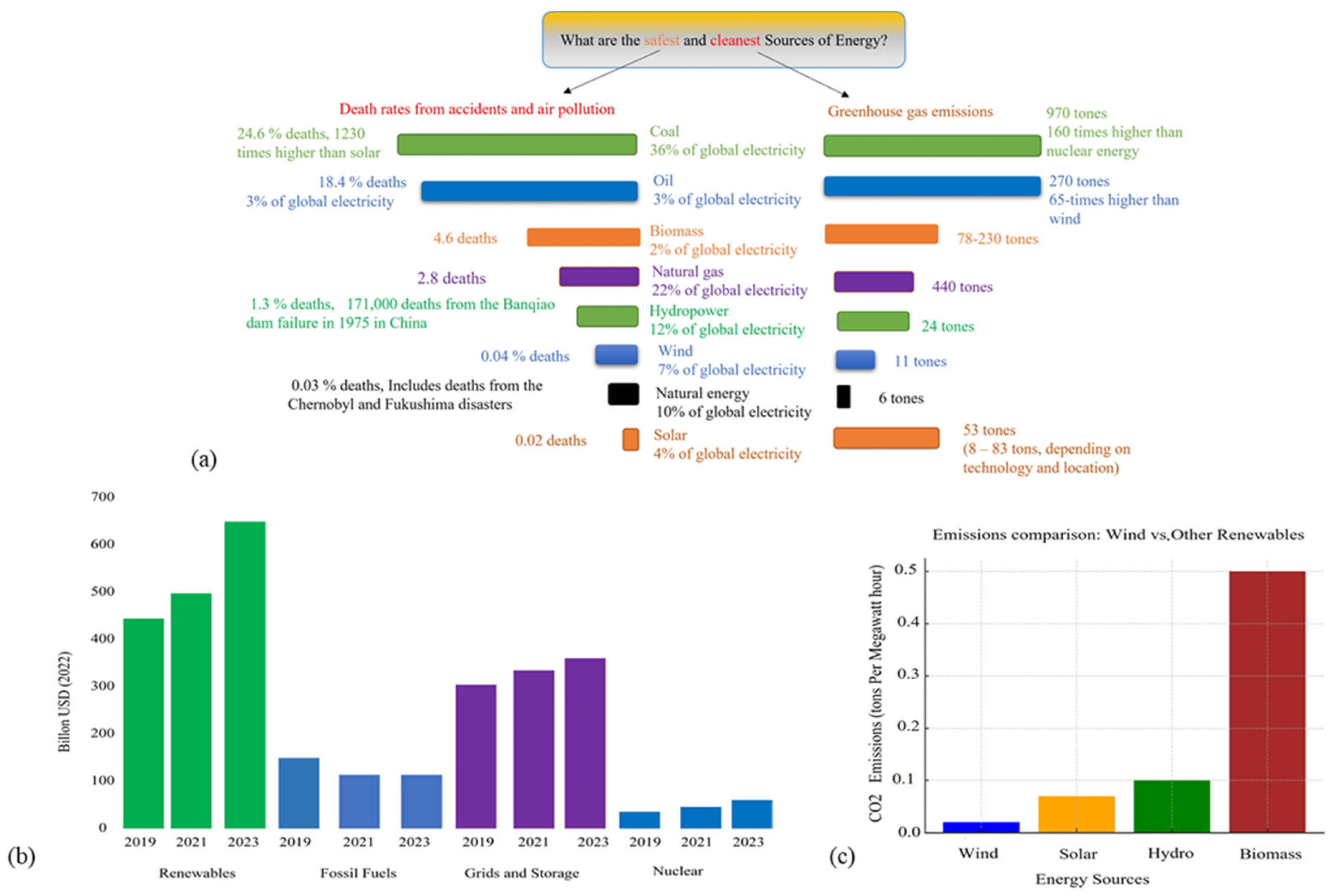
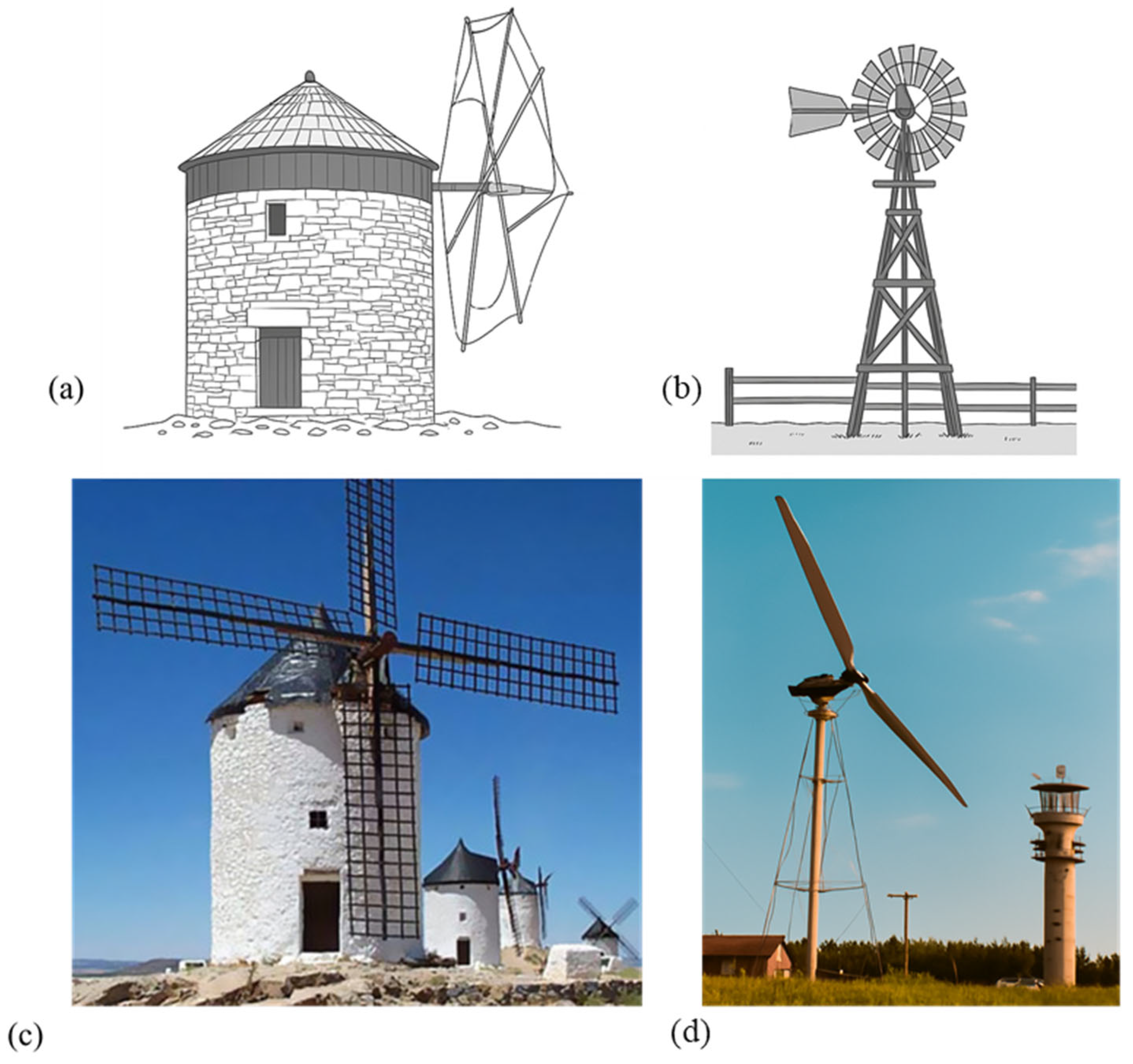
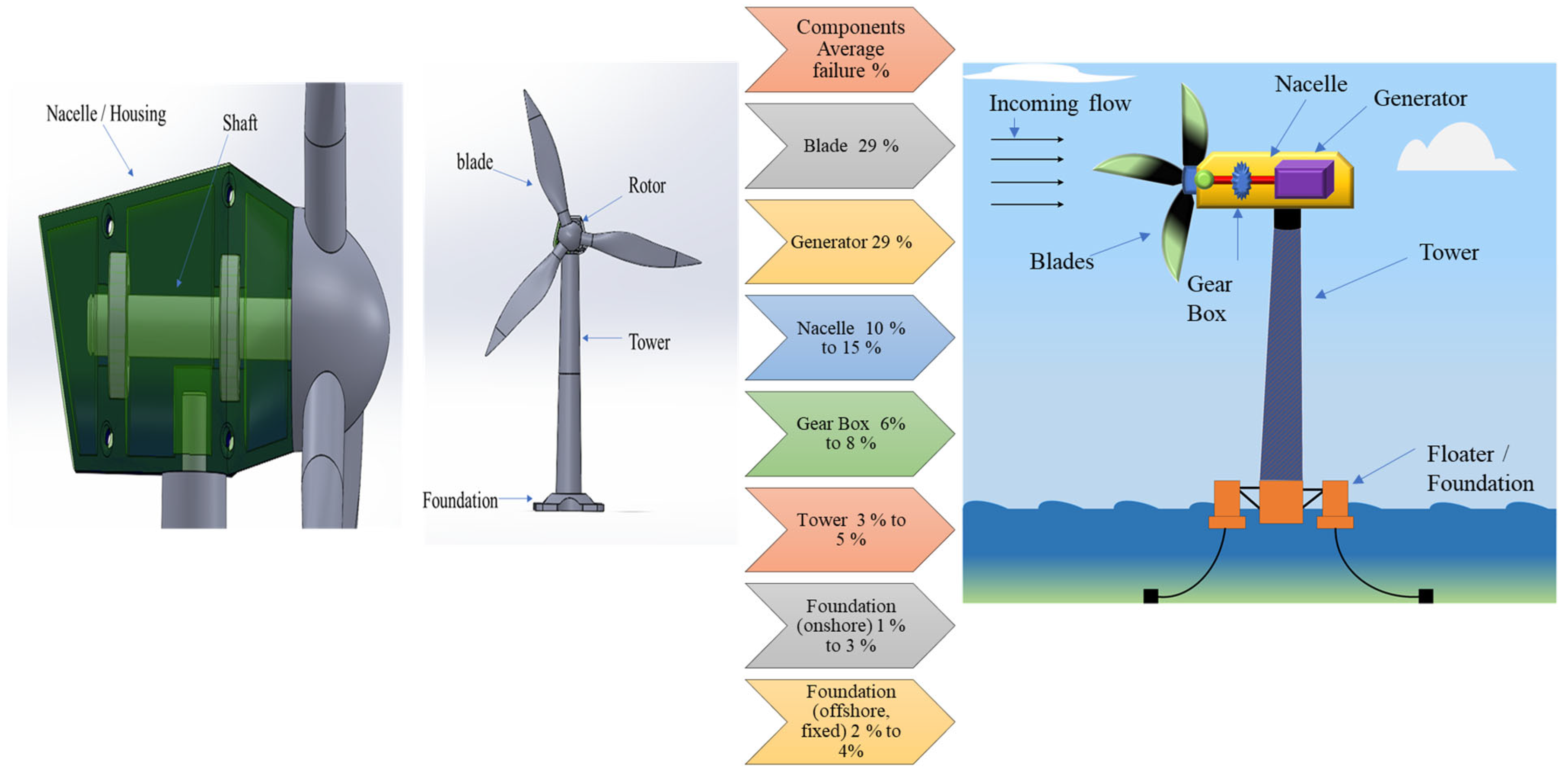

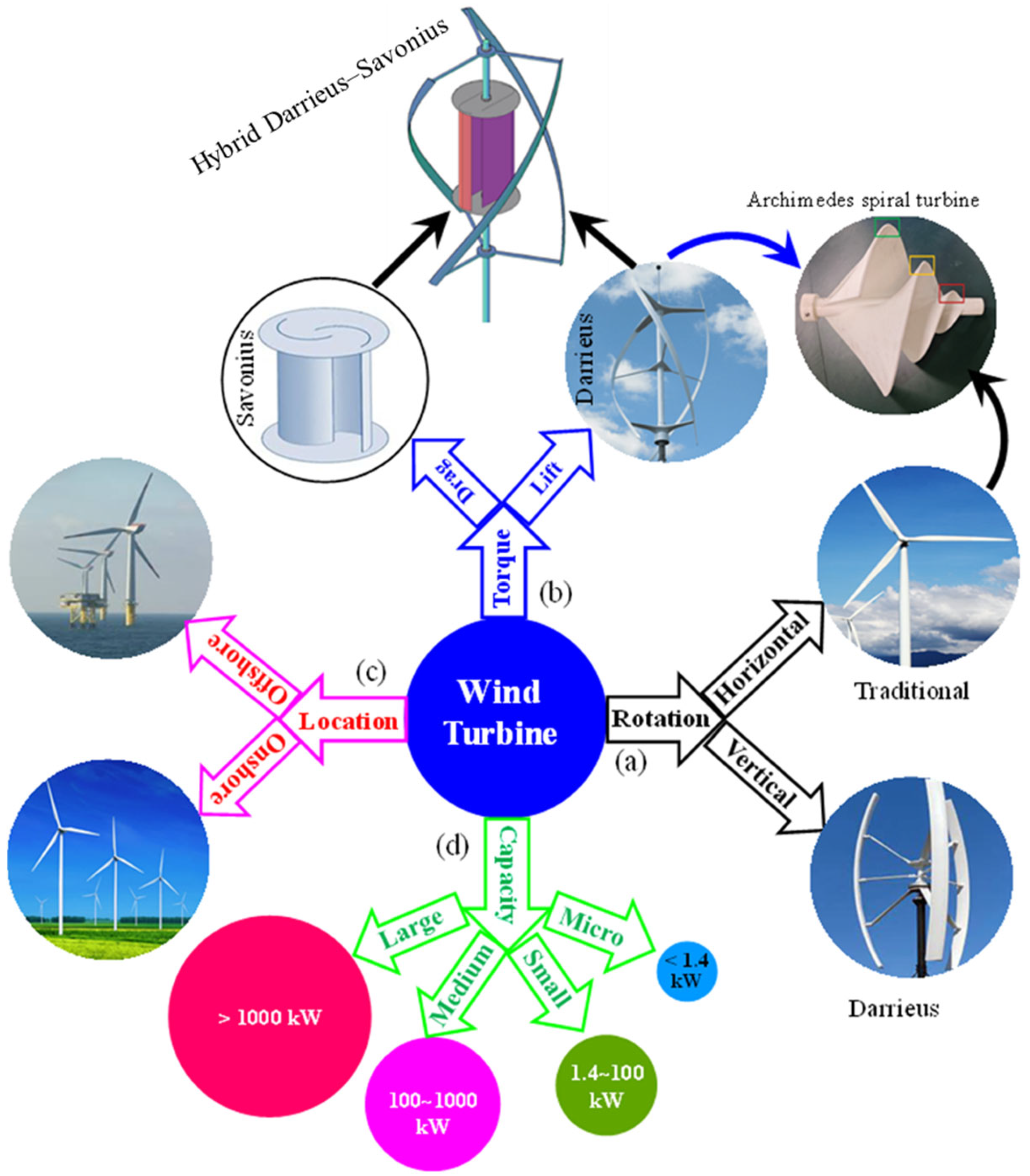
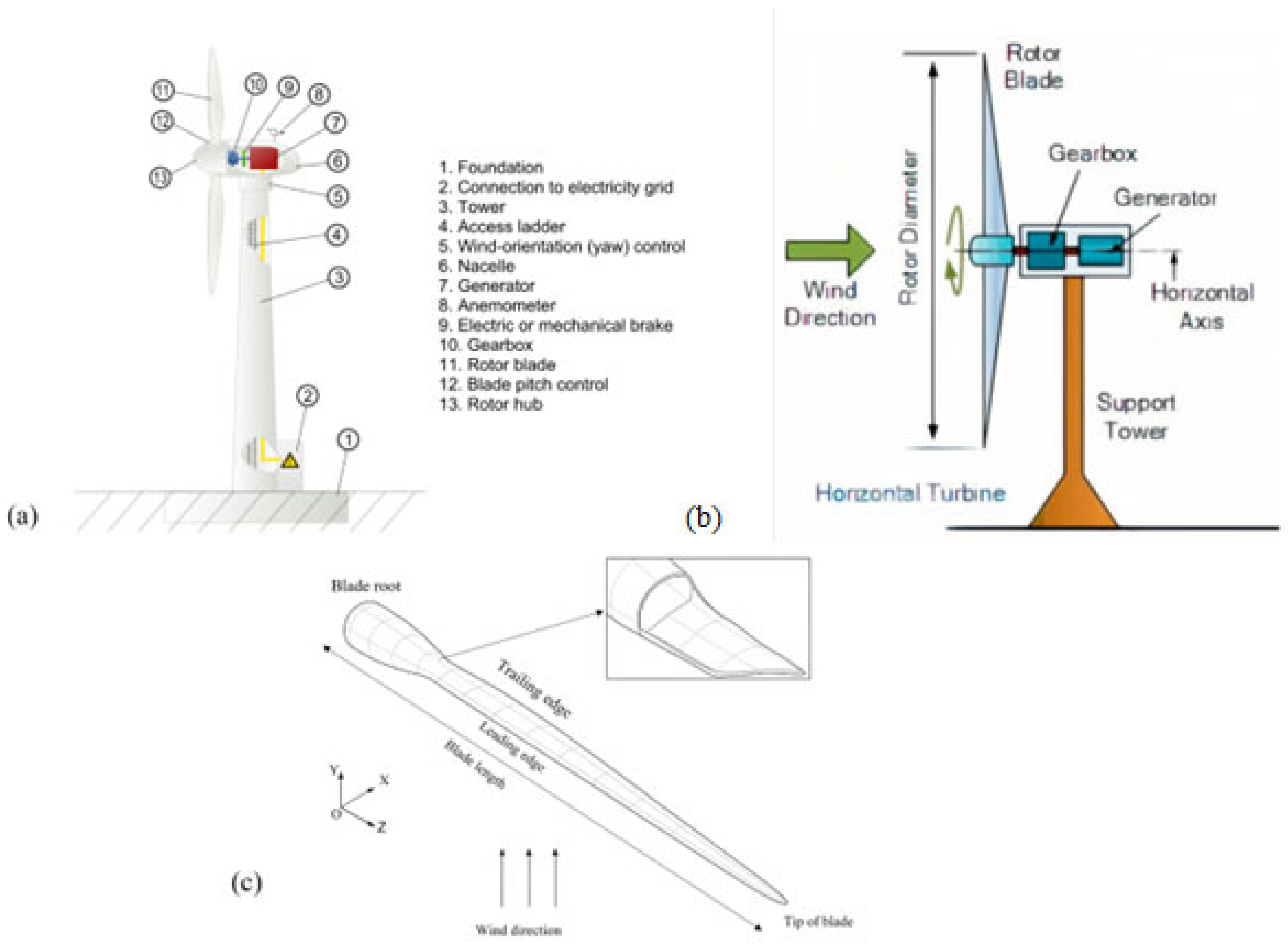
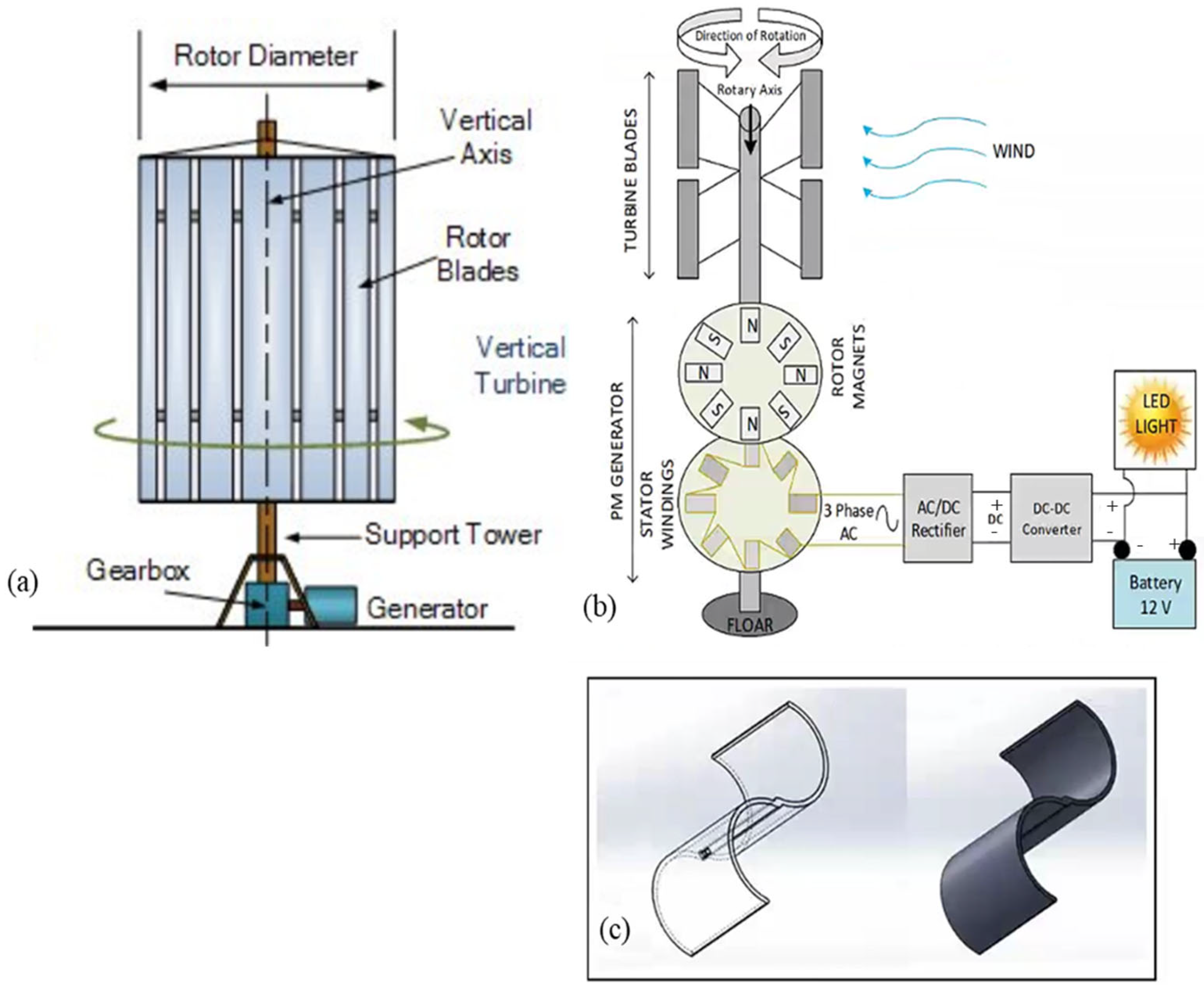
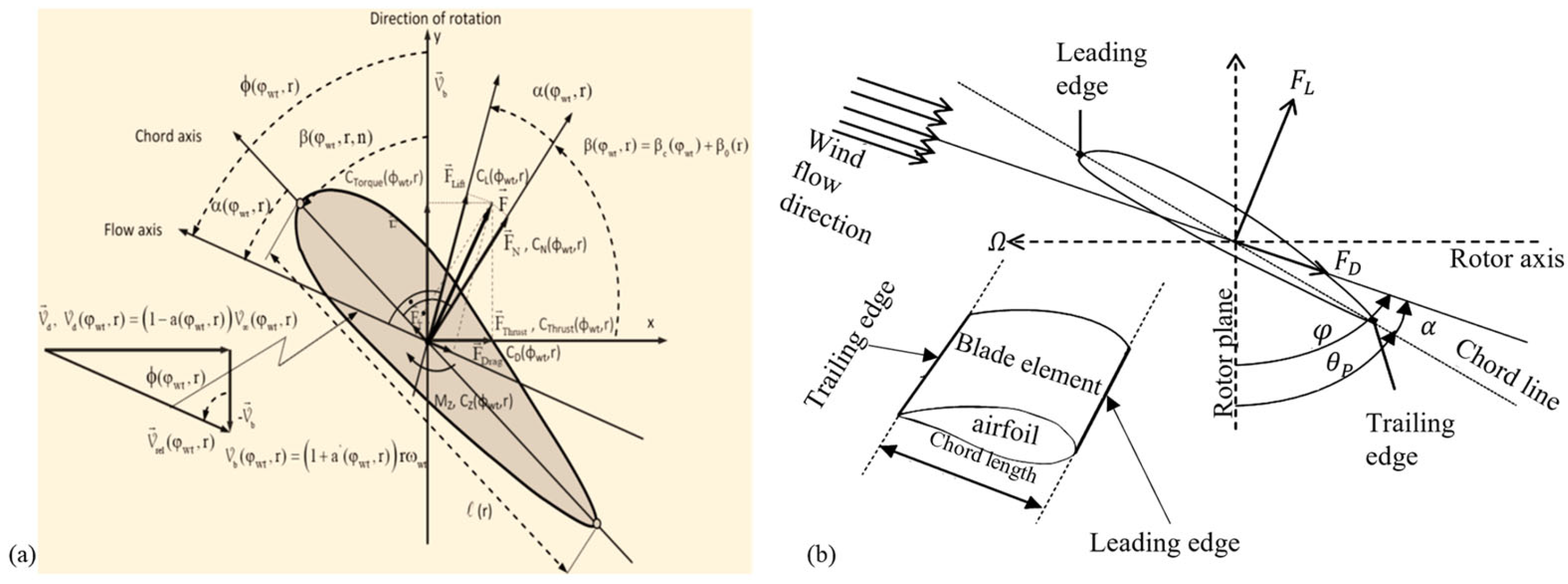
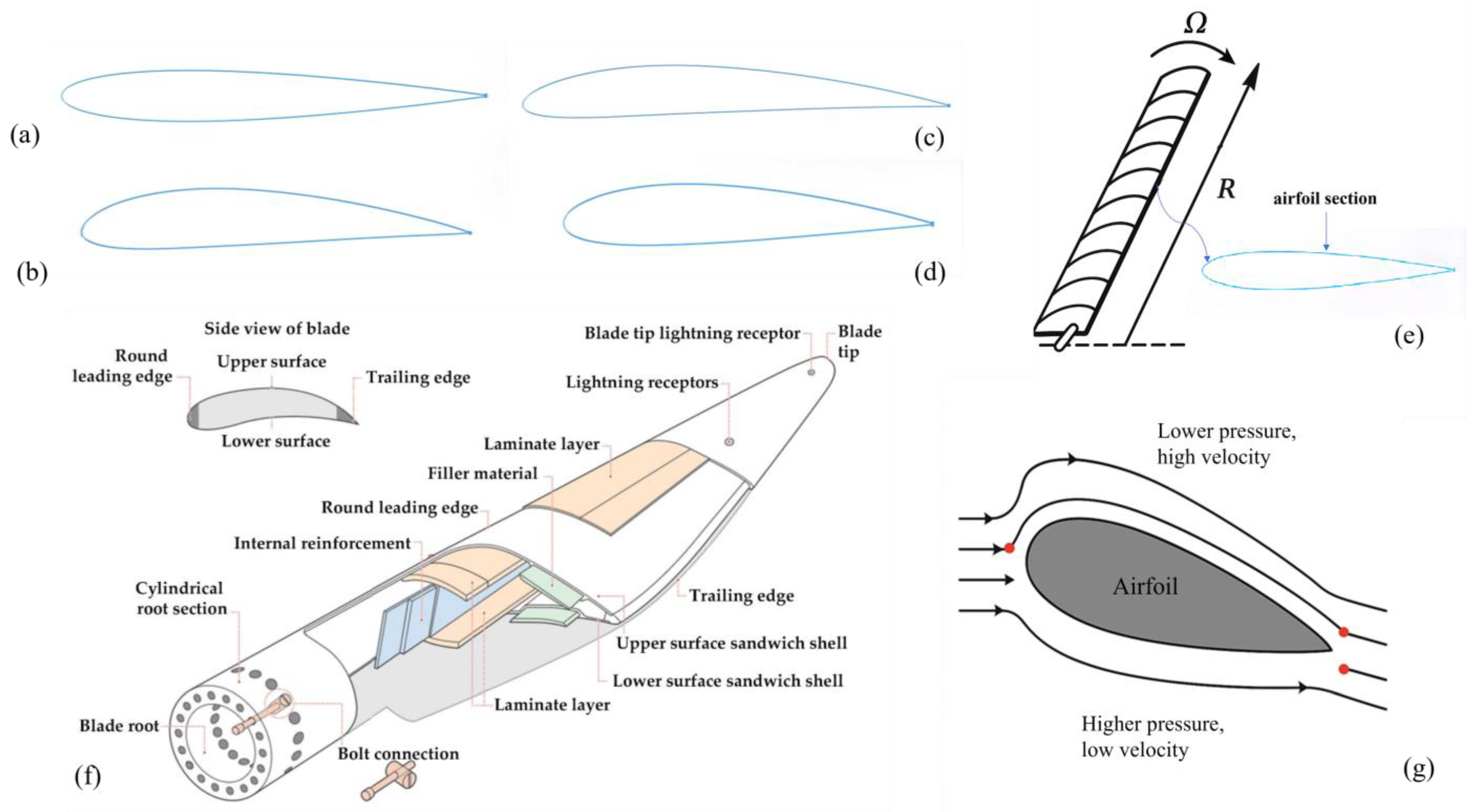

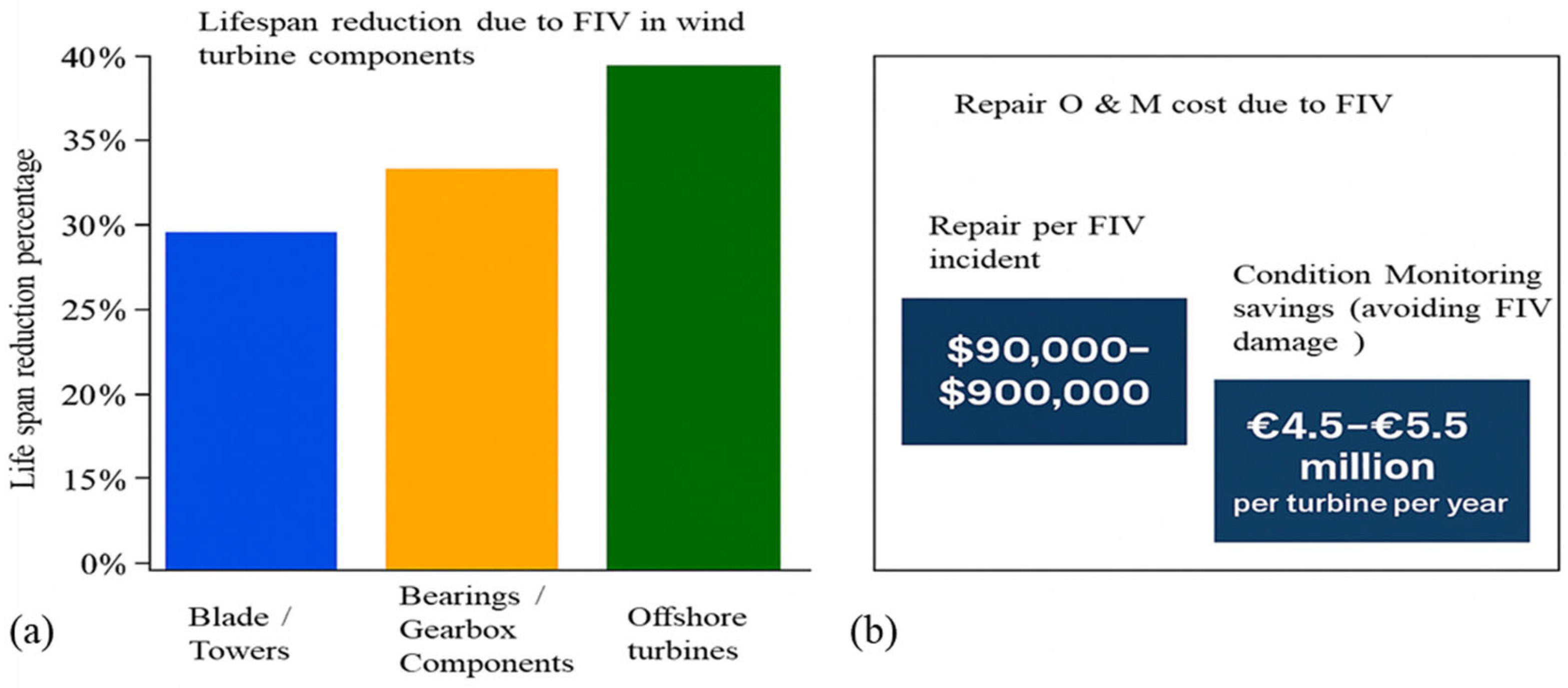
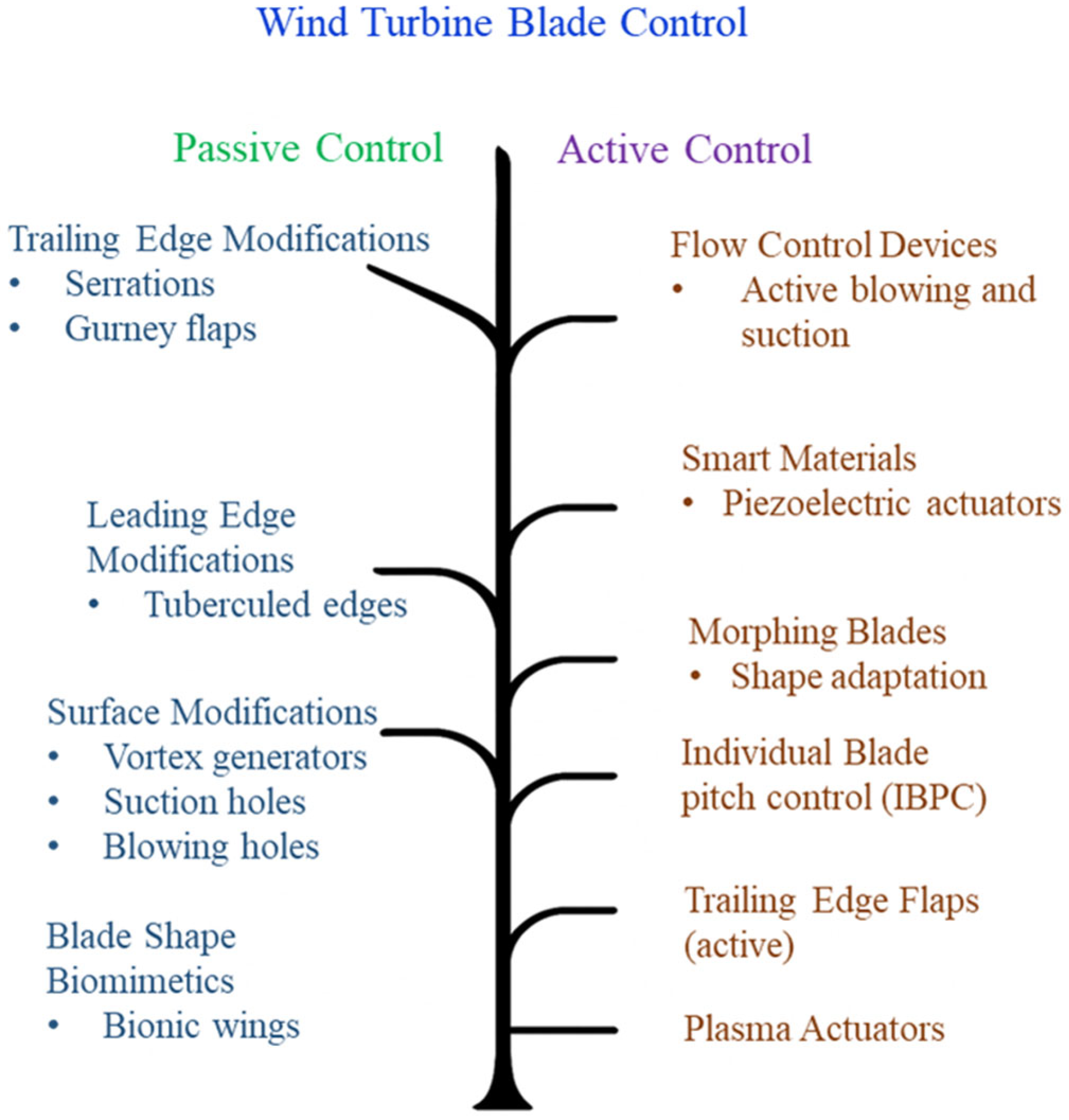
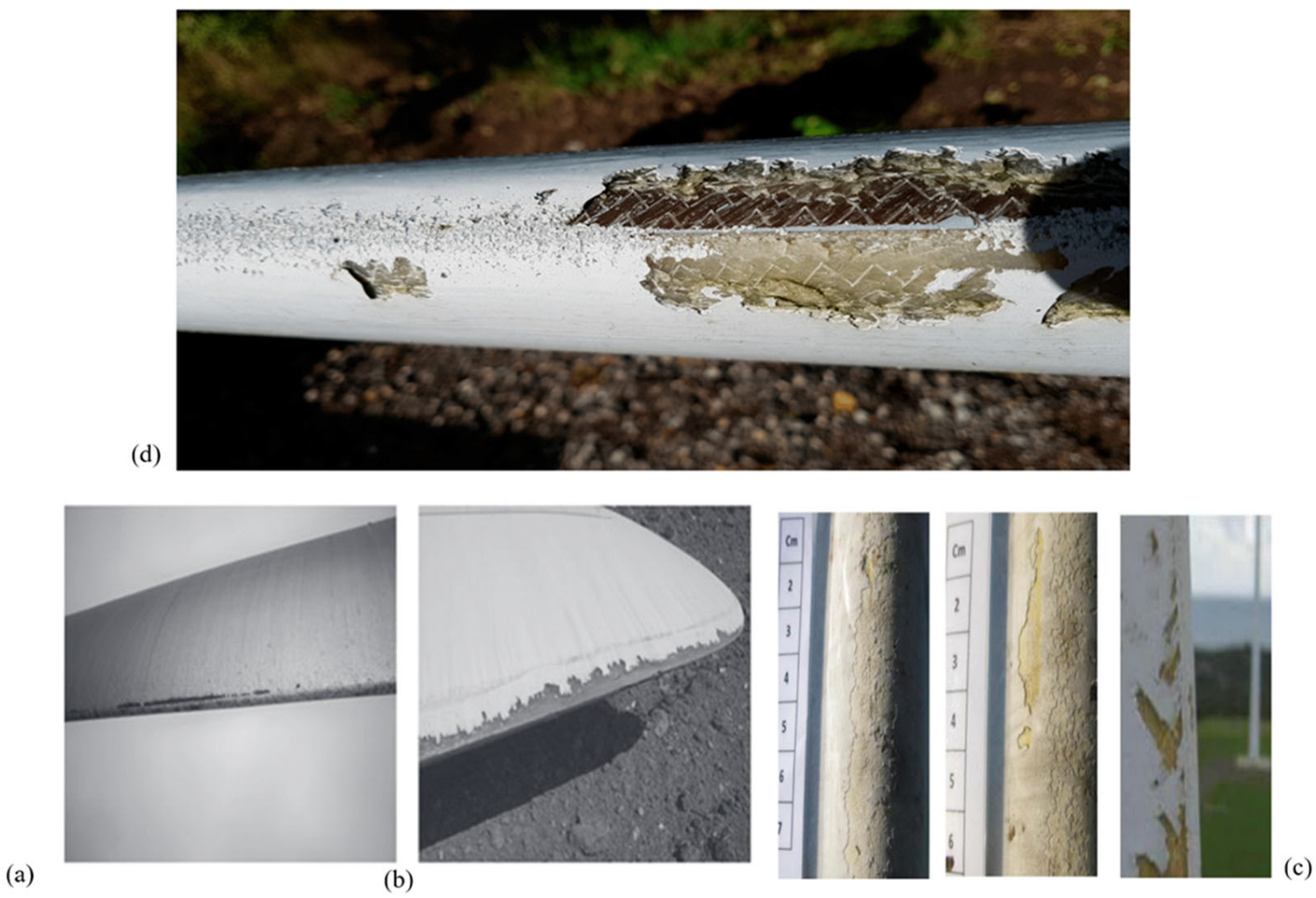
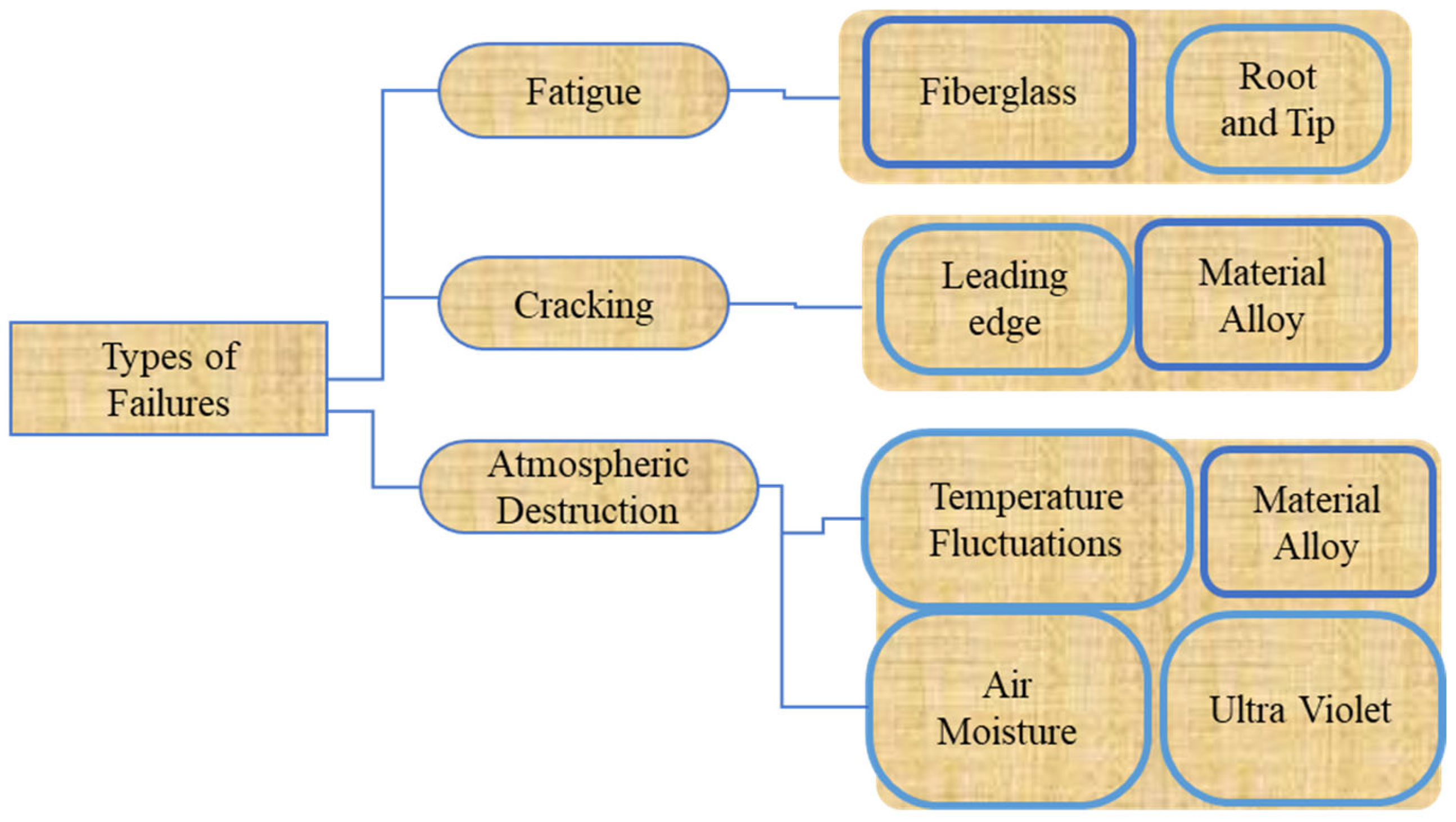
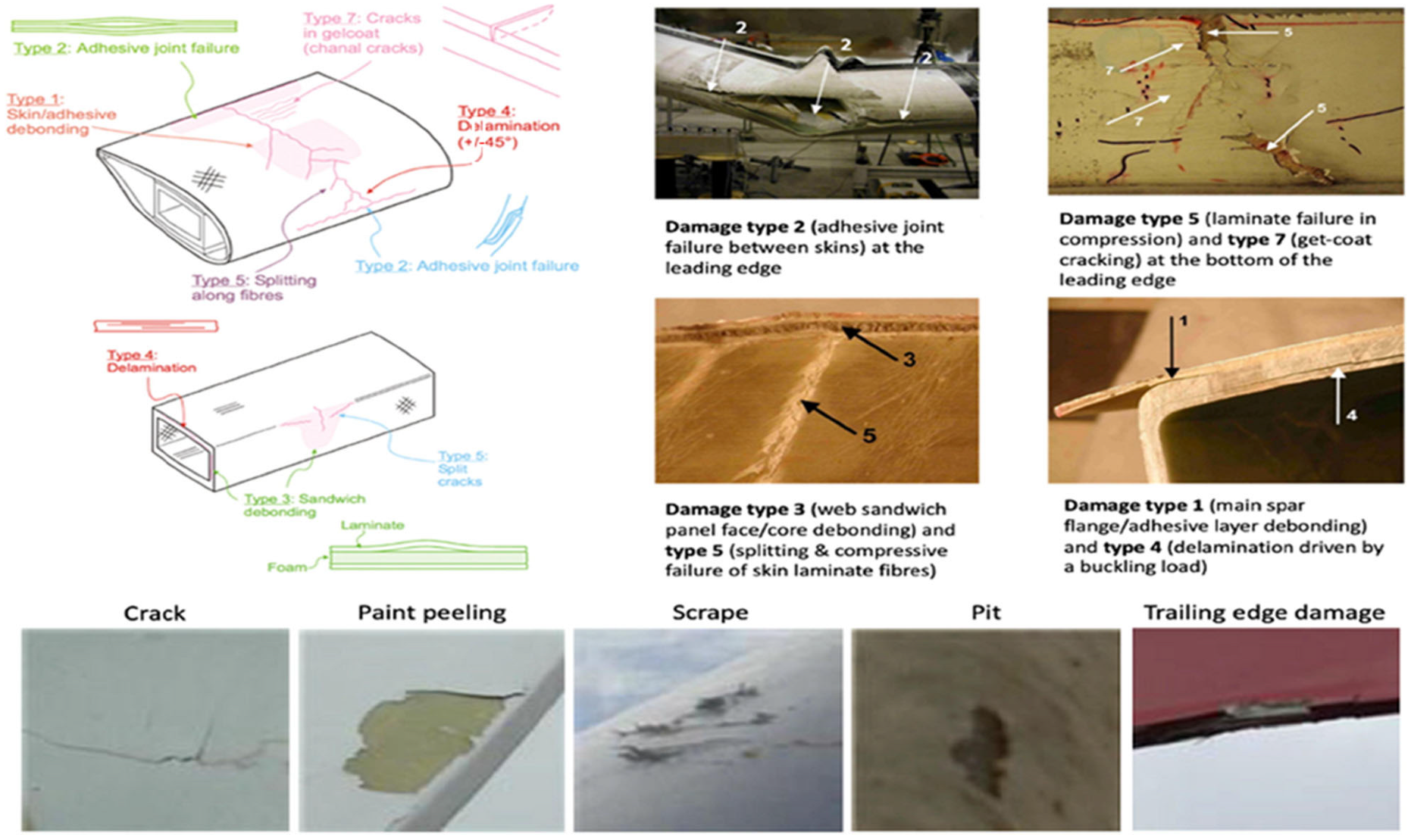
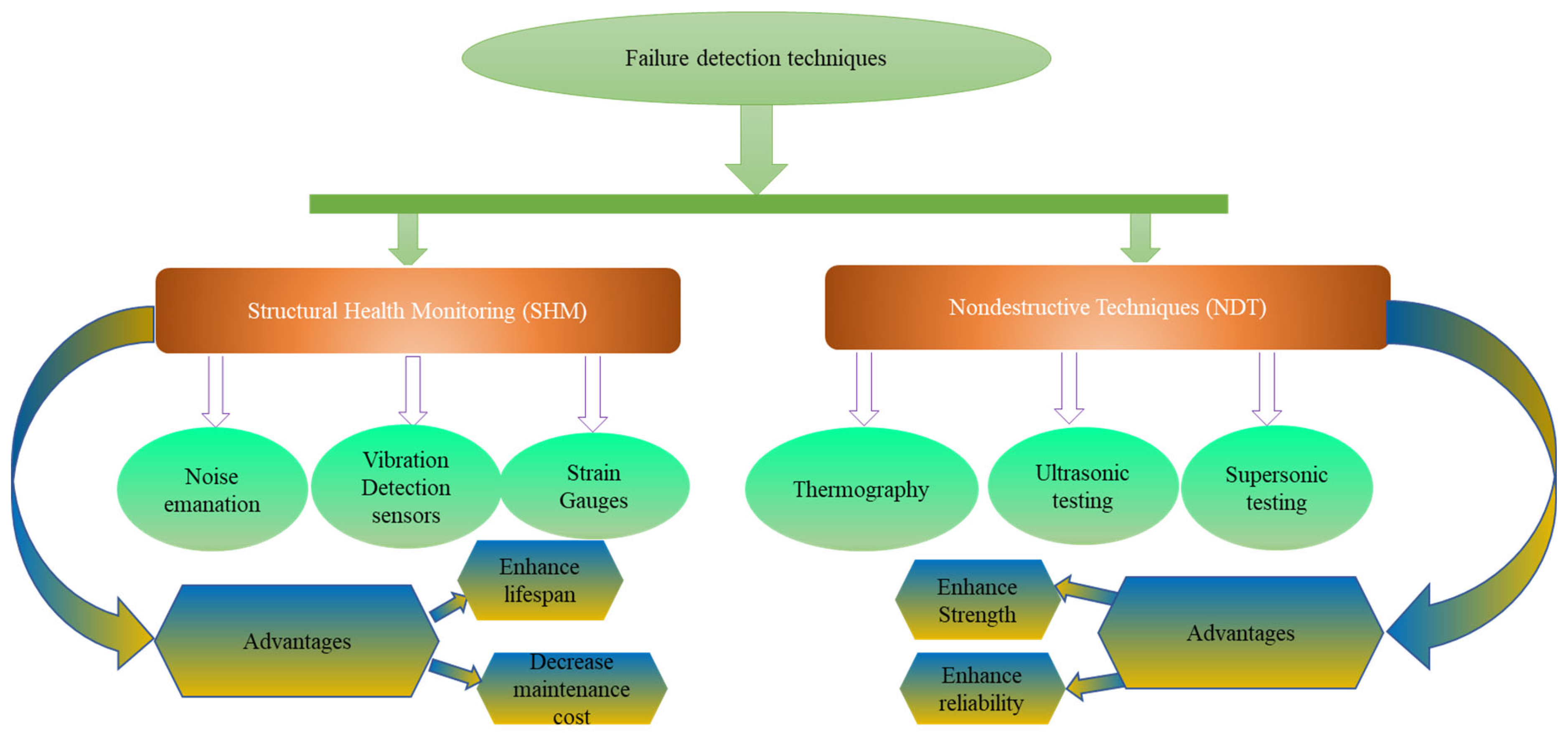

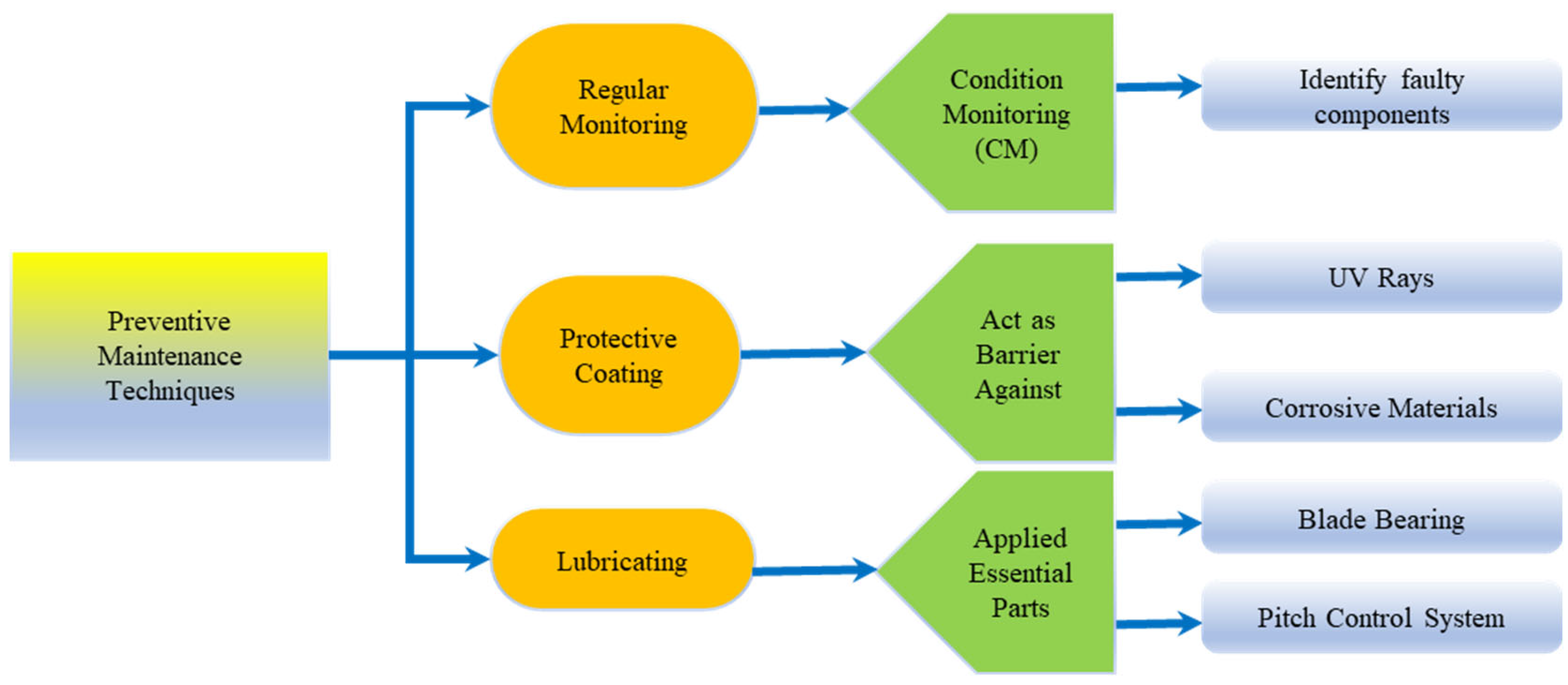
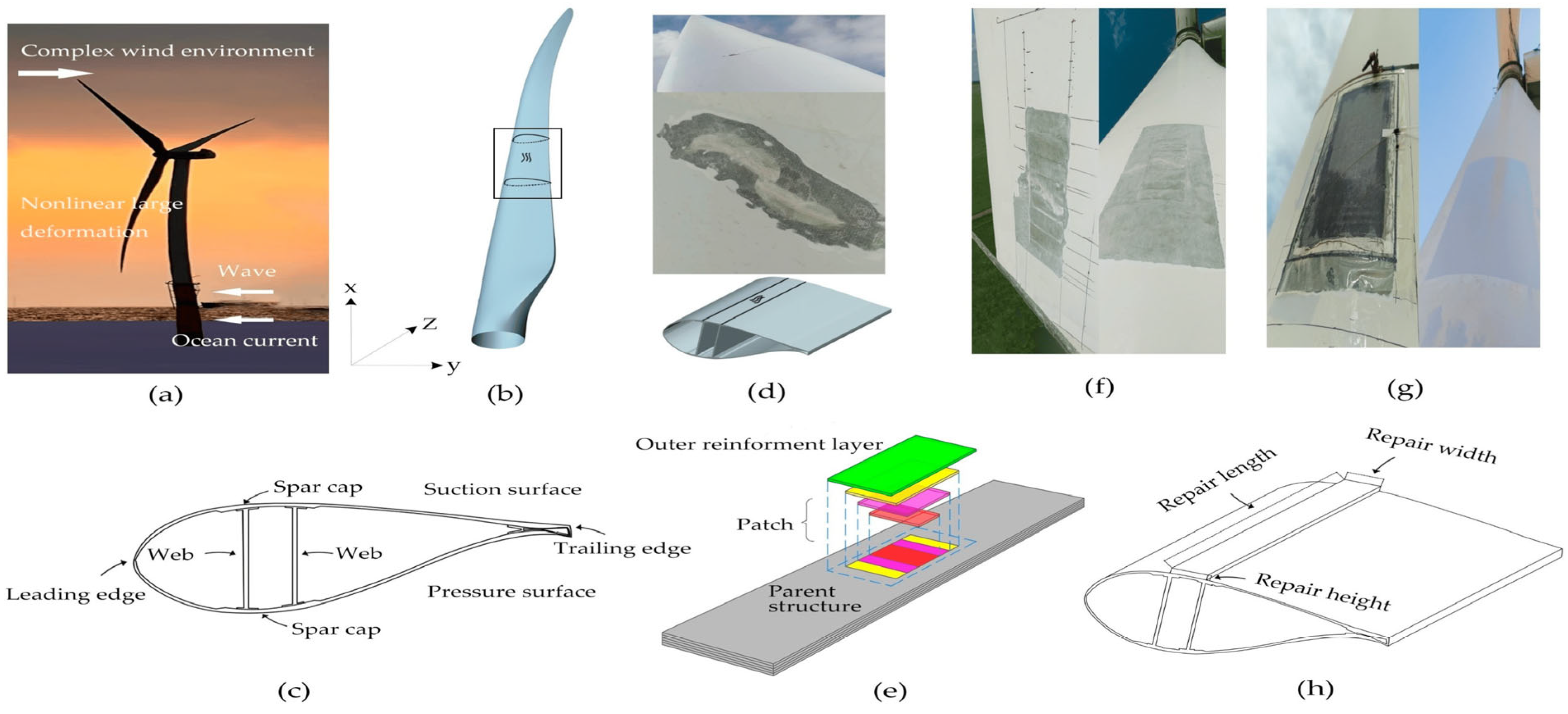
Disclaimer/Publisher’s Note: The statements, opinions and data contained in all publications are solely those of the individual author(s) and contributor(s) and not of MDPI and/or the editor(s). MDPI and/or the editor(s) disclaim responsibility for any injury to people or property resulting from any ideas, methods, instructions or products referred to in the content. |
© 2025 by the authors. Licensee MDPI, Basel, Switzerland. This article is an open access article distributed under the terms and conditions of the Creative Commons Attribution (CC BY) license (https://creativecommons.org/licenses/by/4.0/).
Share and Cite
Naqash, T.M.; Alam, M.M. A State-of-the-Art Review of Wind Turbine Blades: Principles, Flow-Induced Vibrations, Failure, Maintenance, and Vibration Suppression Techniques. Energies 2025, 18, 3319. https://doi.org/10.3390/en18133319
Naqash TM, Alam MM. A State-of-the-Art Review of Wind Turbine Blades: Principles, Flow-Induced Vibrations, Failure, Maintenance, and Vibration Suppression Techniques. Energies. 2025; 18(13):3319. https://doi.org/10.3390/en18133319
Chicago/Turabian StyleNaqash, Tahir Muhammad, and Md. Mahbub Alam. 2025. "A State-of-the-Art Review of Wind Turbine Blades: Principles, Flow-Induced Vibrations, Failure, Maintenance, and Vibration Suppression Techniques" Energies 18, no. 13: 3319. https://doi.org/10.3390/en18133319
APA StyleNaqash, T. M., & Alam, M. M. (2025). A State-of-the-Art Review of Wind Turbine Blades: Principles, Flow-Induced Vibrations, Failure, Maintenance, and Vibration Suppression Techniques. Energies, 18(13), 3319. https://doi.org/10.3390/en18133319







